Vol. 72, No. 2 (2023)
2023-01-20
SPECIAL TOPIC—Two dimensional twisted moiré superlattice

EDITOR'S SUGGESTION
2023, 72 (2): 027102.
doi: 10.7498/aps.72.20222145
Abstract +
Polariton is a quasiparticle generated from strong interaction between a photon and an electric or magnetic dipole-carrying excitation. These polaritons can confine light into a small space that is beyond the diffraction limit of light, thus have greatly advanced the development of nano photonics, nonlinear optics, quantum optics and other related research. Van der Waals two-dimensional (2D) crystals provide an ideal platform for studying nano-polaritons due to reduced material dimensionality. In particular, stacking and twisting offer additional degree of freedom for manipulating polaritons that are not available in a single-layer material. In this paper, we review the near-field optical characterizations of various structures and polaritonic properties of stacked/twisted 2D crystals reported in recent years, including domain structures of stacked few-layer graphene, moiré superlattice structures of twisted 2D crystals, twisted topological polaritons, and twisted chiral plasmons. We also propose several exciting directions for future study of polaritons in stacked/twisted 2D crystals.

EDITOR'S SUGGESTION
2023, 72 (2): 027802.
doi: 10.7498/aps.72.20222080
Abstract +
Moiré superlattices formed by van der Waals materials with small lattice mismatch or twist angle open an unprecedented approach to generate flat bands that don’t exist in the “parent” materials, which provides a controllable platform for exploring quantum many body physics. Owing to the wide angle range for the existence of flat bands, as well as the valley-spin-locking band structure and the excellent optical properties, twisted semiconducting transition metal dichalcogenides (TMDs) heterostructures have recently attracted lots of attention. In this review, we discuss the exotic states discovered in the twisted TMDs heterostructures, including Mott insulator, generalized Wigner crystals, topological non-trivial states, and moiré excitons, how to manipulate these exotic states and related mechanisms, and finally some perspectives on the opportunities and challenges in this field.
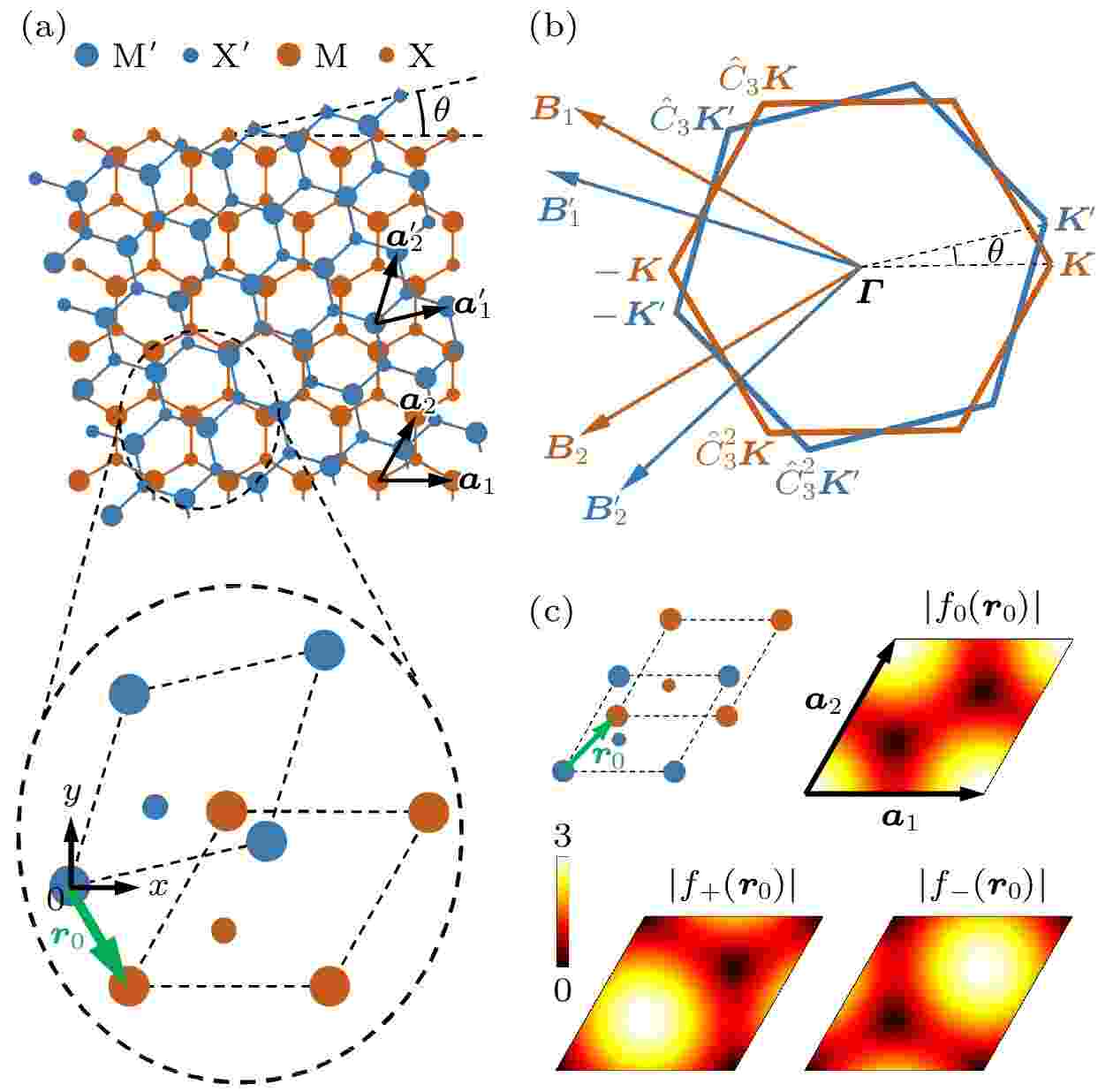
EDITOR'S SUGGESTION
2023, 72 (2): 027302.
doi: 10.7498/aps.72.20222046
Abstract +
In recent years, various novel phenomena have been observed in two-dimensional semiconductor moiré systems, including the moiré excitons, strongly-correlated electronic states and vertical ferroelectricity. To gain an insight into the underlying physical mechanisms of these intriguing phenomena, it is essential to understand the interlayer coupling form of the electrons in moiré systems. In this work, the position- and momentum-dependent interlayer coupling effects in two-dimensional semiconductor moiré superlattices are investigated. Starting from the monolayer Bloch basis, the interlayer coupling between two Bloch states are treated as a perturbation, and the coupling matrix elements in commensurate and incommensurate bilayer structures are obtained, which are found to depend on the momentum and the interlayer translation between the two layers. Under the effect of an external potential, the Bloch states form localized wavepackets, and their interlayer couplings are found to depend on the wavepacket width as well as the interlayer translation at the wavepacket center position. Meanwhile the momentum-dependence results in very different interlayer coupling forms for the ground-state $ \rm{S} $ -type and the excited-state $ {\rm{P}}^{\pm } $ -type wavepackets. It is shown that at a position where the interlayer coupling between two $ \rm{S} $ -type wavepackets vanishes, the coupling between an $ \rm{S} $ -type wavepacket and a $ {\rm{P}}^{+} $ -type wavepacket (or between an $ \rm{S} $ - type wavepacket and a $ {\rm{P}}^{-} $ -type wavepacket) reaches a maximum strength. This can be used to manipulate the valley-selective interlayer transport of the ground-state wavepackets through external electric and optical fields. Besides, the vertical ferroelectricity recently discovered in bilayer systems can be attributed to the charge redistribution induced by the coupling between conduction and valence bands in different layers. Using the obtained interlayer coupling form combined with a simplified tight-binding model for the monolayer, the vertical electric dipole density can be calculated whose form and order of magnitude accord with the experimental observations.
GENERAL
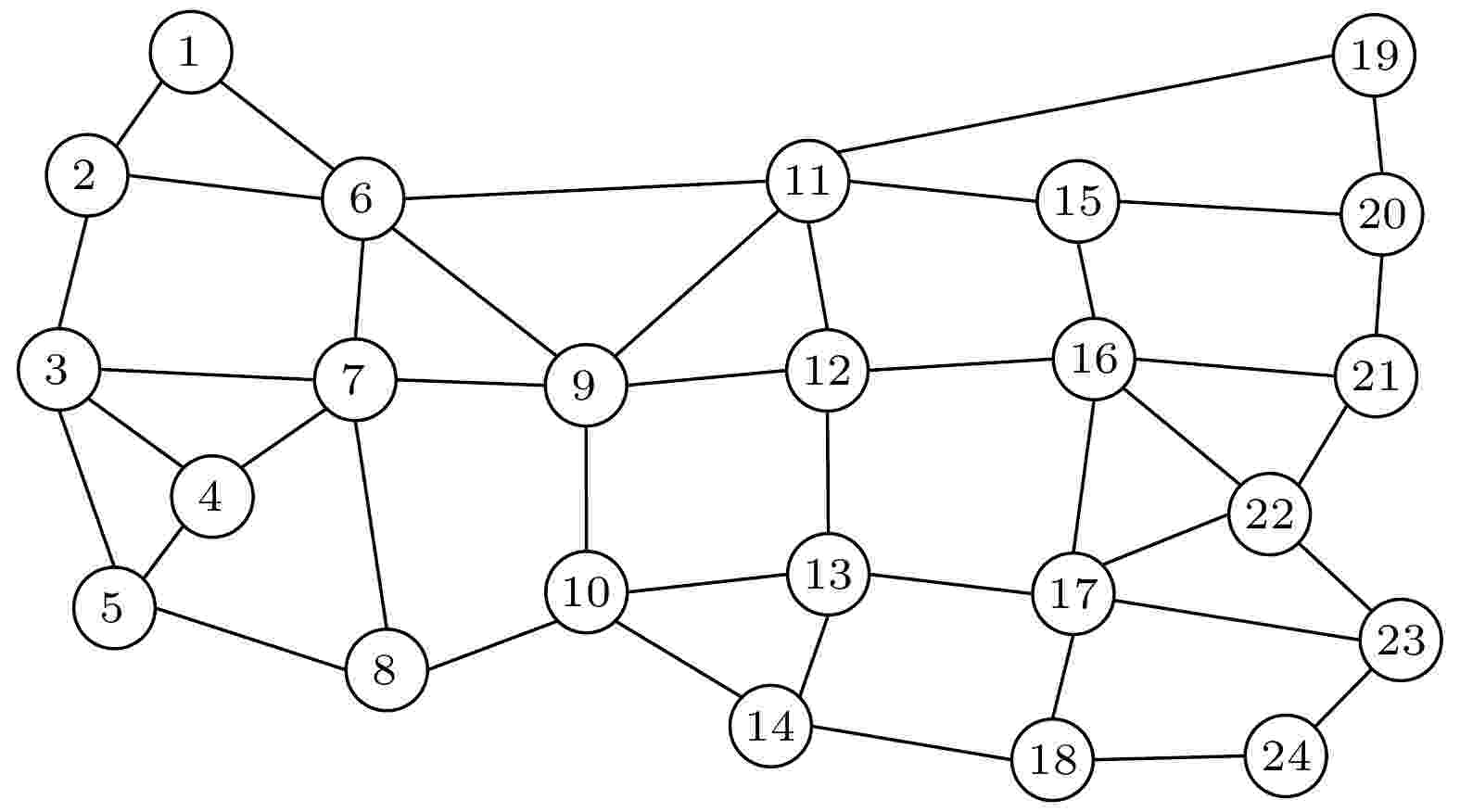
2023, 72 (2): 020301.
doi: 10.7498/aps.72.20221661
Abstract +
In the application research of large-scale quantum communication network, one generally realizes resource allocation by constructing virtual service network and mapping it to actual physical space. In this mapping process, some assumptions are often made to simplify the model. For example, the key resource in the physical topology is assumed to be a fixed value, that is, the actual physical conditions and the performance differences of key supply caused by different protocols are ignored. This assumption may lead the network to fail to run appropriately in practical applications. In order to solve the above problems, from the perspective of link mapping, this paper proposes an improved virtual service mapping model and virtual service mapping algorithm with the quantum key distribution optical network as the underlying network, which makes it closer to the actual application scenario. On the one hand, by increasing the constraints of geographical location, the range from virtual nodes to the mappable physical nodes is reasonably restricted. On the other hand, from the perspective of hardware cost and actual key generation rate, the cost performance evaluation index is proposed to allocate and manage resources. In addition, by combining three mainstream quantum key distribution protocols (BB84, measurement-device-independent, and twin-field), we construct a universal virtual service mapping model in the quantum key distribution optical network, and realize the recommendation of the optimal protocol and the optimal allocation and management of resources.
2023, 72 (2): 020302.
doi: 10.7498/aps.72.20221684
Abstract +
Aiming at the problem that traditional quantum secure direct communication schemes need to assume the legitimacy of both parties in advance, a GHZ state (a quantum state involving at least three subsystems or particles entanglement) based quantum secure direct communication scheme with identity authentication is proposed. The scheme first encodes GHZ state particles into eight types, divides the particles into three parts, and sends them three times. Each time, eavesdropping is added to detect whether the particle detection channel is secure, and identity authentication is added when sending particles for the second time to verify the identity of the receiver. Specifically, according to the value of the ID key IDA, the specified particles (such as $ |0\rangle $ particles or $ |+ \rangle $ particles) are found in the two particles. Then their positions are marked as L and they traverse down until all the identity keys are traversed, obtaining a position sequence L. After sending the two particles to Bob for eavesdropping detection, Bob measures the L position of the two particles on the corresponding basis according to the value of the identity key, the measurement results are coded, and compared with the identity key IDA to complete the identity authentication. After sending the particles for the third time. the receiver extracts all the detected particles, and then the GHZ state particles are jointly measured, and the original information is recovered through the previously given coding rules, so as to realize quantum safe direct communication. The design of this scheme is simple and efficient, and the communication can be realized without complex unitary transformation. The correctness analysis proves that the scheme is correct in theory. The security analyses of interception/measurement retransmission attack, Trojan horse attack, denial of service attack, auxiliary particle attack, identity impersonation attack, and other attacks prove that the scheme can resist common internal attacks and external attacks, and solve the problem of information leakage. The transmission efficiency of the scheme is 1, the quantum bit utilization is 1, and the coding capacity is a quantum state carrying 3 bits of information. Compared with some previous schemes, this scheme has obvious advantages in these three aspects. The biggest advantage is that the sender does not need to assume the legitimacy of the receiver when sending information, so it has high practical application value.

2023, 72 (2): 020701.
doi: 10.7498/aps.72.20221841
Abstract +
Under the condition of 5.6 GPa and 1250–1450 ℃, the diamond single crystals are synthesized in a cubic anvil high-pressure and high-temperature apparatus. High-purity FeNiCo solvents or NiMnCo solvents are chosen as the catalysts. High-purity (99.99%) graphite powders selected as a carbon source. High-quality abrasive grade diamond single crystals with relatively developed (100) or (111) crystal planes are used as crystal seeds. The effects of catalyst composition on crack defects in diamond single crystals are studied carefully. Firstly, using FeNiCo and NiMnCo catalysts respectively, we carry out the diamond single crystal growth experiments. It is found that under the same crystal growth condition, the probability of crystal crack defects in diamond single crystals grown with FeNiCo catalyst is significantly higher than that of crystals grown with NiMnCo catalyst. We believe that this is related to the high viscosity, poor fluidity of FeNiCo catalyst melt, and the large specific surface area of the crystal during growth, which leads to its high requirements for the stability of growth conditions. Secondly, the relationship between the growth time and the limit weight gain speed of the diamond single crystal synthesized, respectively, by FeNiCo catalyst and NiMnCo catalyst are investigated. The results are shown below. 1) The limiting growth rate of diamond single crystal increases with the growth time going by. 2) In the same growth time, the limit growth rate of diamond crystal grown with NiMnCo catalyst is higher than that of diamond crystal grown with NiMnCo catalyst. Thirdly, by scanning electron microscopy (SEM), we calibrate the surface morphology of the synthesized diamond single crystal. The test results show that the diamond single crystal has a high surface flatness. Even for the crystals with crack defects in the interior, the surface flatness is still good. However, Fourier transform infrared (FTIR) measurements show that the nitrogen impurity content of diamond crystal grown by FeNiCo catalyst with crack defect is about 3.66×10–4. The content of nitrogen impurity in the crystal grown by NiMnCo catalyst without crack defect is about 4.88×10–4. The results show that there is no direct correlation between nitrogen impurity content and crack defects in diamond crystal.
THE PHYSICS OF ELEMENTARY PARTICLES AND FIELDS
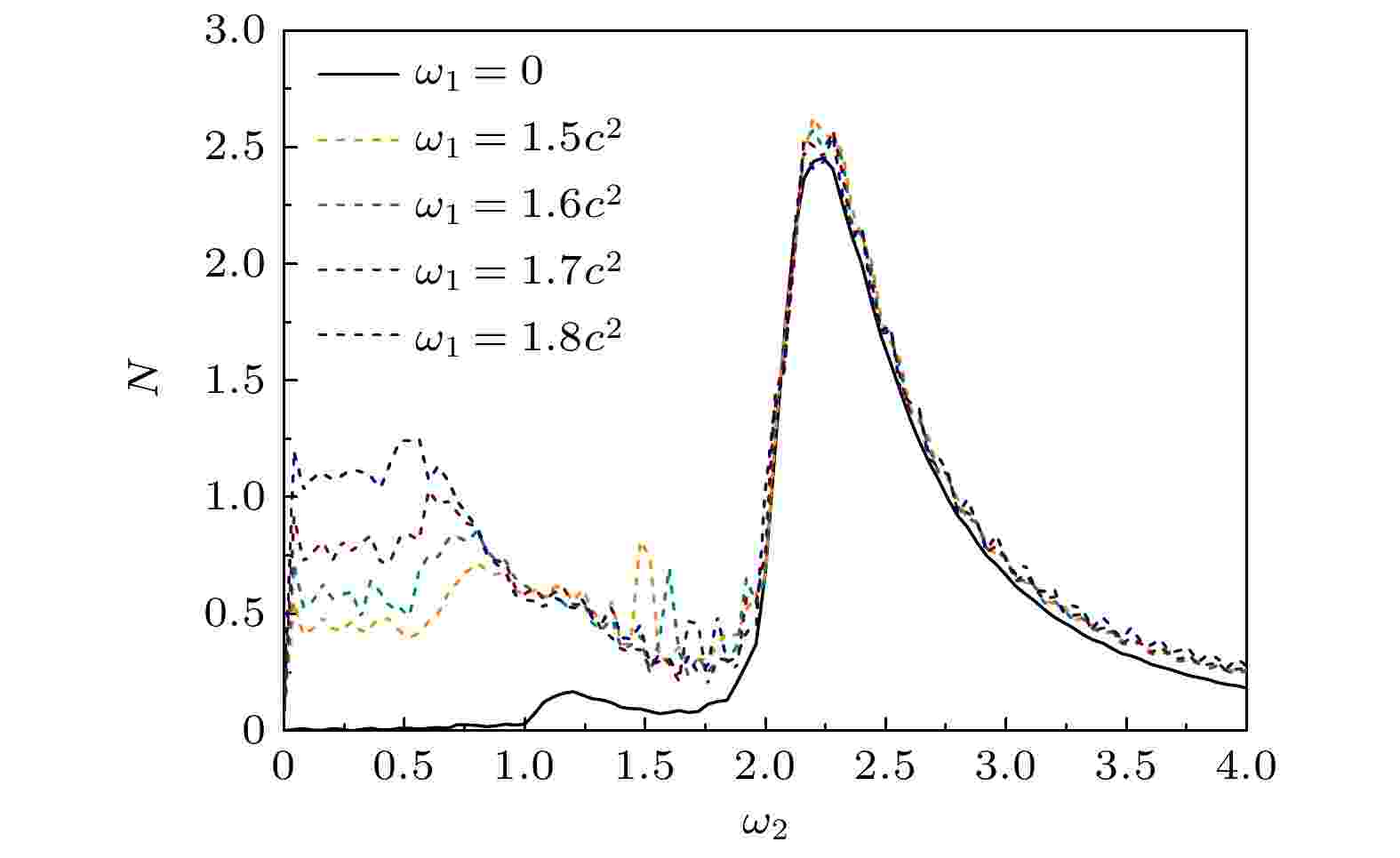
2023, 72 (2): 021201.
doi: 10.7498/aps.72.20221660
Abstract +
We study the creation of electron-positron pairs in vacuum induced by multi-photon transition process with combined oscillating fields. According to the computational quantum field theory and the split operator technique, we numerically solve the spatiotemporally dependent Dirac equation. The effects of field frequencies on the yields and energy distributions of electron-positron pairs are investigated.First, we show that even for subcritical fields, the goal of generating electron-positron pairs continuously can be achieved by combining two oscillating fields. We also find that when the sum of the field frequencies is close to $ 2.3c ^ 2 $ (a.u.), the yield of the created pairs reaches a maximum value. In the case that only one oscillating filed is involved and single photon transition is dominant, the pair creation is also optimal at this frequency. In this way, the sum of the frequencies of the combined fields is fixed at $ 2.3c^2 $ in the later simulations. For example, oscillating fields with $\omega_1=1.1c^{2},\; \omega_2= 1.2c^{2}$ ; $\omega_1=1.0c^{2},\; \omega_2= 1.3c^{2}$ ; $ \omega_1=0.8c^{2}, $ $ \omega_2= 1.5c^{2} $ ; $\omega_1=0.5c^{2},\; \omega_2= 1.8c^{2}$ ; and $\omega_1=0.4c^{2},\; \omega_2= 1.9c^{2}$ are applied to the following study.The time evolutions of the yield of the electron-positron pairs under different frequency combinations are investigated. It is found that when the frequencies of the two fields are close to each other, the growth rate ${\rm{d}}N/{\rm{d}}t$ presents an obvious periodic variation, showing a “beat” - like structure. The “beat” - like structure is found to be synchronized with the synthesized electric field. Meanwhile, the long-term growth rate ${\rm{d}}N/{\rm{d}}t$ of the pairs increases significantly when the field frequency difference becomes larger.The energy distributions of the electron-positron pairs created at different frequency combinations are studied. It is found that when the frequency difference is small (eg, $\omega_1=1.0c^{2},\; \omega_2= 1.3c^{2}$ ), the energy distribution of the particles shows a quasi-monoenergetic feature, with most of the particles distributed around $ 1.1c^{2}-1.2c^{2} $ . For a large frequency difference (eg, $\omega_1=0.5c^{2},\; \omega_2= 1.8c^{2}$ ), the total yield of the pairs greatly increases. Meanwhile, the energy range of the particles is broadened significantly with the generation of more energetic particles.By analyzing and comparing the probability distributions of transitions between the negative energy and the positive energy, we find that the main reason for the spectrum-broadening and the yield-increasing is the enhancement of the multi-photon transition process. Beside the two-photon transition ($ \omega_{1}+\omega_{2} $ ), which is of high probability in all the cases, the higher-order photon transitions ($2\omega_{1}+\omega_{2},\;3\omega_{1}+\omega_{2},\;4\omega_{1}+\omega_{2}$ ) will arise with probability in the same order as the two-photon transition. These multi-photon transitions enhance the creation of the electron-positron pairs, especially the high-energy pairs. The second reason is that for a narrow field width ($ W=2/c $ ), the conservation of the momentum breaks down, the generation of electron-positron pairs corresponding to the asymmetric transitions becomes important, which further enhances the pair production and broadens the energy distribution.For a wide field width ($ W=5/c $ ), the probability of high-order photon transitions and the asymmetric transitions are suppressed compared with the case of narrow field width ($ W=2/c $ ). However, the frequencies of the combined fields still have important influence on the pair productions and energy distributions.
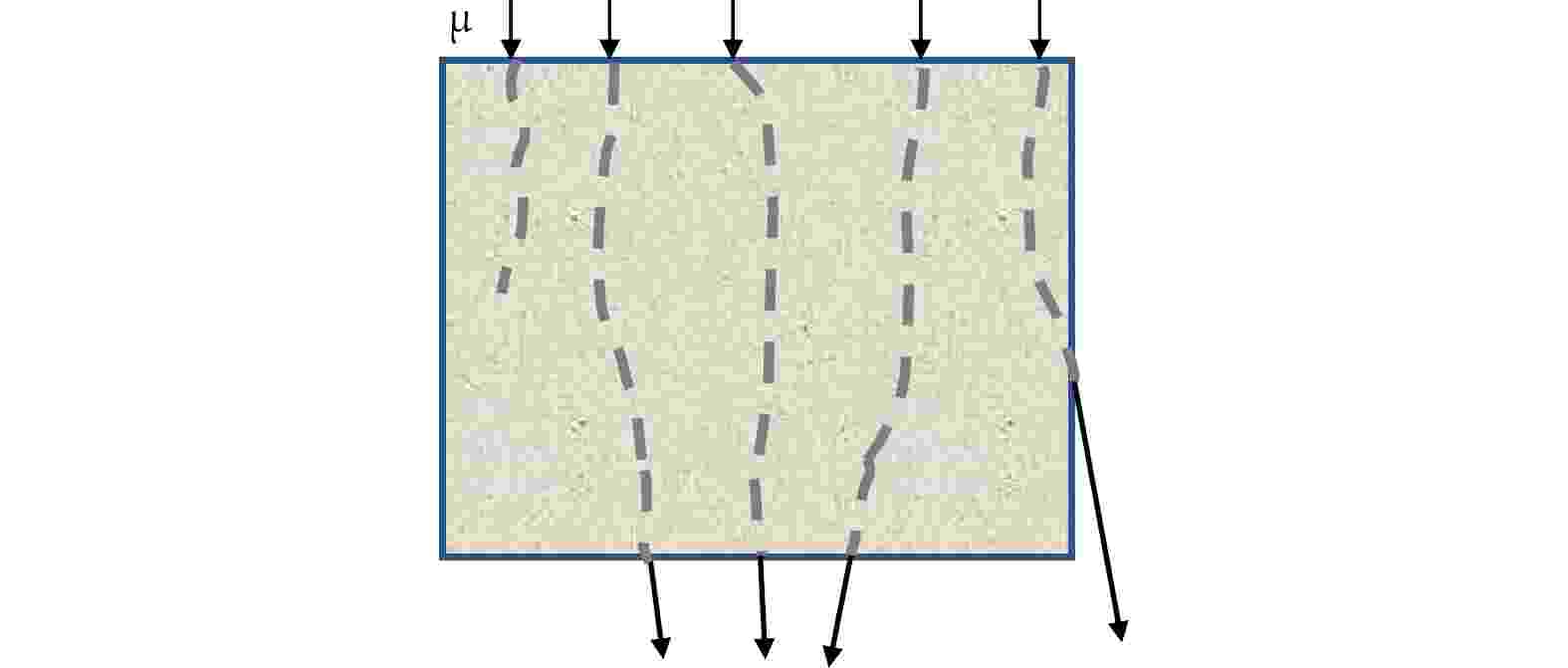
2023, 72 (2): 021401.
doi: 10.7498/aps.72.20221792
Abstract +
The muon transmission imaging method is a non-destructive detection imaging method and can obtain the internal density structure of the target object by analyzing the flux change of cosmic ray muon before and after passing through the target object. This method assumes that muon travels along a straight line in a lowatomic number material. However, the multiple Coulomb scattering causes the muon deviate from the straight line to a certain extent when penetrating the material, which may have a certain influence on the accuracy of muon transmission imaging. This study uses the Geant4 software package to carry out Monte Carlo simulation of muon transmission imaging. Object models with multiple density structures and several meters are used to analyze the effect of multiple scattering on the accuracy of transmission imaging. In the experiment, we set up a model in which muons of different energy vertically pass through a rock with a certain thickness, we can intuitively see the influence of scattering on the penetration path of muons. By setting up rock-water block models with thickness in a range of 0.8, 2.4 and 4.0 m, the effect of Coulomb scattering on the transmission imaging of small-scale material muons is analyzed. The results suggest that the muon transmission imaging method can well restore the geometric shape and spatial distribution characteristics of density anomalies for objects with several-meter scale for standard rock materials with a scale of several meters. However, the flux deviation caused by multiple Coulomb scattering on the muons in the near-vertical direction can reach 5%, and up to 13% in the boundary areas of the standard rock and air. We limit the scattering angle of the muon, and select the muon with a scattering angle of less than or equal to 1° for imaging. The results of transmission imaging by using the selected muon have improved. The image does not have the illusion of an abnormally increased flux around the model caused by scattering, but the muon flux in the model area is reduced even more, thereby affecting the accuracy of restoring the absolute density of an object using flux differences. Therefore, the effects of multiple Coulomb scattering should be considered for recovering more accurate absolute density in small-scale muon transmission imaging study.
NUCLEAR PHYSICS

EDITOR'S SUGGESTION
2023, 72 (2): 022601.
doi: 10.7498/aps.72.20221599
Abstract +
The research on the macroscopic properties of neutron stars is of great significance in revealing the internal composition and structure of neutron star. In this work, We analyze the influence of δ mesons on the equation of states, the maximum mass, the tidal Love numbers and the tidal deformabilities for the conventional neutron stars and the hyperon stars within the relativistic mean field theory. It is found that the presence of δ mesons can strengthen the tidal deformabilities of the low and medium-mass conventional neutron stars (or hyperon stars). However, the strengthening trends of the tidal deformabilities with δ mesons gradually weaken with the increase of the mass of the conventional neutron stars (or hyperon stars). Especially for massive hyperon stars, the tidal deformabilities of the superstars with δ mesons is weaker than the corresponding values without δ mesons. Moreover, the presence of hyperons can reduce the tidal deformabilities of stars with the same mass. For the stars containing δ mesons, only the tidal deformabilities in the hyperon stars with Λ, Σ and Ξ hyperons can satisfy the constraints of GW170817 and GW190814 events under the parameters selected in the paper. As the data about gravitational waves associated with the neutron stars gradually increase, there will be a possible way of judging the hyperon species in the hyperon stars.
ELECTROMAGNETISM, OPTICS, ACOUSTICS, HEAT TRANSFER, CLASSICAL MECHANICS, AND FLUID DYNAMICS
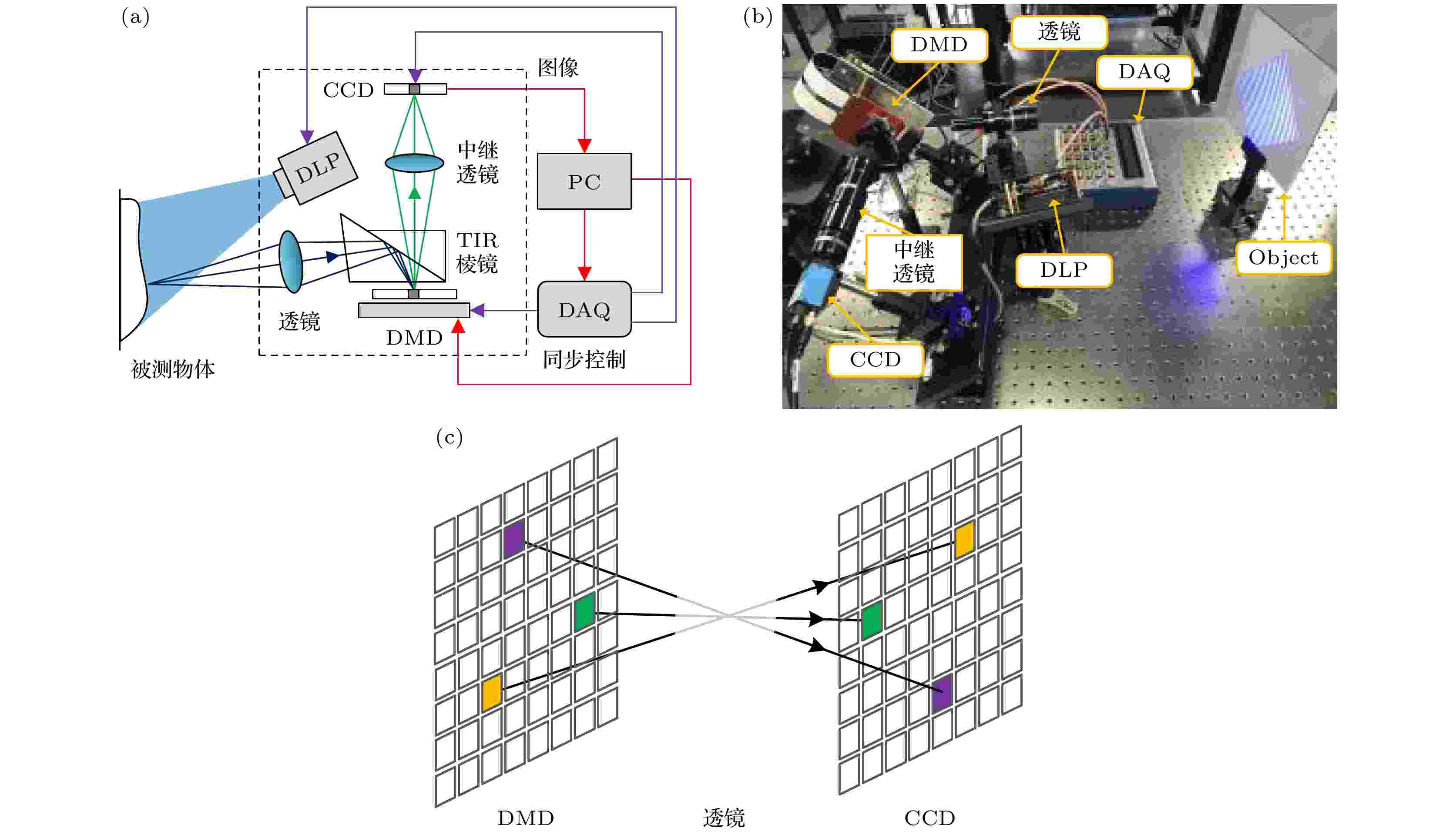
2023, 72 (2): 024201.
doi: 10.7498/aps.72.20221588
Abstract +
Pixel-wise coded exposure (PCE) imaging based on digital micromirror device (DMD) is an advanced high-speed imaging technology, which can realize the high-speed imaging by using a low-frame-rate camera. During exposure time, the multi-frame image information of a dynamic object can be integrated into one encoded image, and then the multi-frame sub-exposure images can be extracted by the post-processing algorithm. Therefore, the accurate pixel-to-pixel alignment between the DMD and the camera is the key step to realize PCE imaging, which has drawn much attention from researchers. So their studies mainly focused on how to achieve accurate pixel matching. However, the resolution of the relay imaging lens, as another important influence factor of PCE imaging, also has a significant influence on the imaging results, but few people have studied and analyzed it. To solve this problem, in this work, we theoretically analyze the influence of the resolution of the relay imaging system on the reconstructed decoded images, and verifies the theoretical analysis through simulation and imaging experiments. On this basis, a PCE imaging system is built, and a point spread function (PSF) estimation method of relay lens based on the fringe phase is proposed. Furthermore, a Richard-Lucy deconvolution algorithm is introduced into the reconstruction process of coded image to effectively improve the quality of PCE imaging, which is of great significance in developing the PCE imaging technology.

2023, 72 (2): 024202.
doi: 10.7498/aps.72.20221438
Abstract +
In this paper, we demonstrate a new imaging architecture called time-space united coding spread spectrum single photon counting imaging technique by combining the space coding based single-pixel imaging technology and spread spectrum time coding based scanning imaging technology. This method has the advantages of range ambiguity-free and large time-bandwidth product. Under the interference of noise, this method can accurately restore depth images. In this work, the time-space united correlation nonlinear detection model based on single photon detection, forward imaging model and signal-to-noise ratio model is derived, and the depth image is restored by convex optimization inversion algorithm. The theoretical model and simulation experiments show that compared with the traditional single pixel imaging method based on spatial coding, this method improves the quality of scene reconstruction. Using m-sequence as time coding, imaging has higher noise robustness. In addition, compared with the traditional space coding single pixel imaging technology, the imaging mean square error of the proposed method is reduced by 4/5 and the imaging mean squared error is reduced by 9/10 after introducing the second correlated method. The proposed imaging architecture in this paper may provide a new path for non-scanning lidar imaging methods.

2023, 72 (2): 024203.
doi: 10.7498/aps.72.20221690
Abstract +
At present, spatial light modulators are incapable of modulating both the amplitude and phase of the wavefront simultaneously. Therefore, when a spatial light modulator is used for holographic display, it is necessary to encode the complex amplitude of the object wave into amplitude-only or phase-only computer-generated-hologram. The phase-only holographic display has attracted much attention of researchers due to its characteristics of high diffraction efficiency and no conjugate image. However, current optimization algorithms for generating phase-only hologram have the problems of iterative divergence, slow convergence speed, and poor reconstruction quality, which is difficult to satisfy the requirements for high-quality holographic display. In this work, we propose an accurate adaptive mixed constraint Gerchberg-Saxton algorithm by constraining the frequency bandwidth in the hologram plane and adaptively constraining the amplitude of the reconstructed image in the image plane based on the angular spectrum propagation theory. Firstly, we use the angular spectrum propagation model without paraxial approximation to simulate the forward and backward propagation of the light wave for ensuring the accuracy of the wavefront propagation. Secondly, dividing the image plane into signal area and noise area according to the spatial distribution of target image, and different adaptive feedback strategies are set up for the two regions based on the optimized effect of the phase-only hologram. The adaptive feedback strategy is established, which can accelerate the convergence speed of the proposed algorithm and enhance the hologram of freedom of the optimization. Finally, the frequency bandwidth constraint strategy is introduced in the hologram plane to optimize the edge pixels and compensate for the frequency information loss of the phase-only computer-generated hologram, which improves the reconstruction quality of the hologram. After 100 iterations, the average correlation coefficient of the holographic reconstructed image of the proposed algorithm is about 0.9857, and the average peak signal-to-noise ratio is about 31.02 dB. The correlation coefficient and the peak signal-to-noise ratio of the reconstructed images of the proposed algorithm are better than those of the Gerchberg-Saxton algorithm with only frequency bandwidth constraint strategy, and the proposed algorithm has clearer texture and better display effect. The results of numerical simulations and optical experiments show the feasibility and effectiveness of the proposed method. The proposed adaptive mixed constraint Gerchberg-Saxton algorithm is a promising technology for high-quality holographic display.
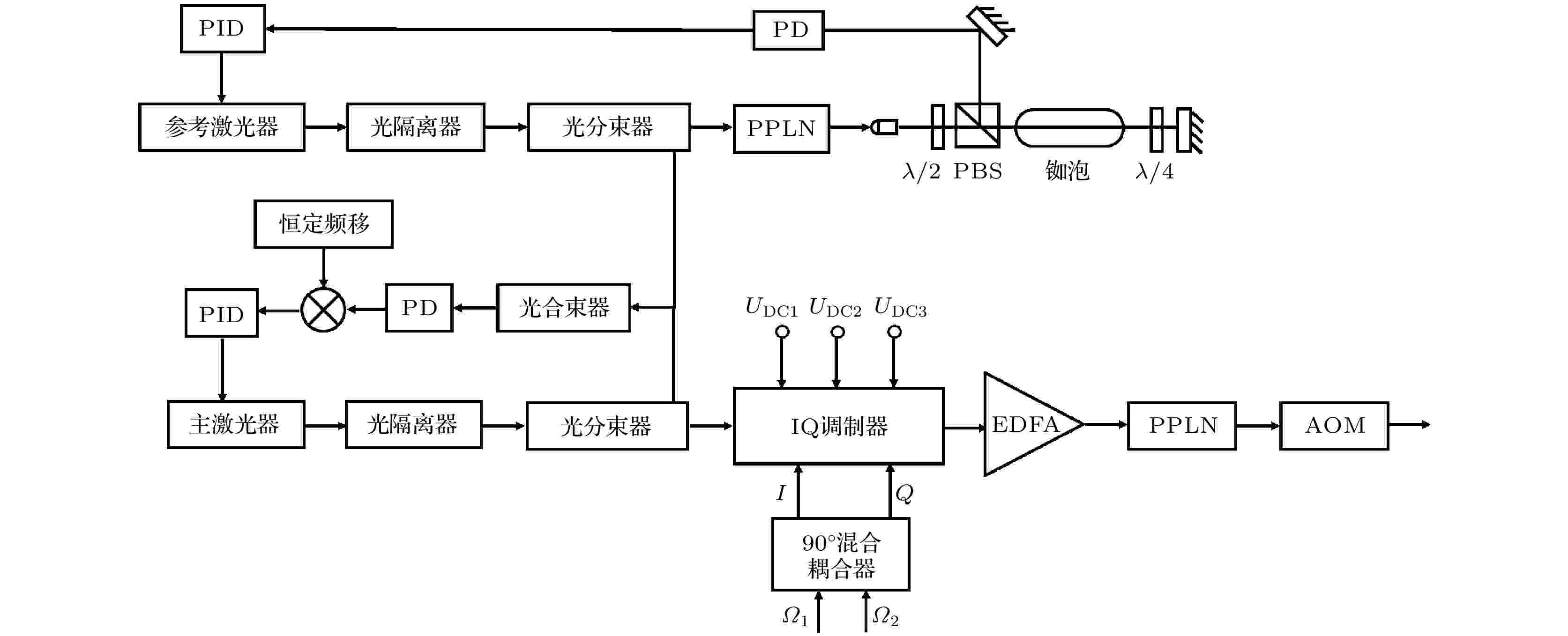
2023, 72 (2): 024204.
doi: 10.7498/aps.72.20221711
Abstract +
Using the electro-optical modulation method to generate Raman beams for cold atom interference is one of the better methods for constructing a more compact and robust laser system. But this way will generate some residual sidebands resulting in the additional interference phase shift, which can affect the measurement accuracy of cold atom interferometer. In order to weaken the effect of laser modulation sidebands on the phase shift of cold atom interference, a double-sideband suppressed-carrier modulation laser system for cold atom interference is constructed. Based on the designed laser system, the principle of double-sideband generation and suppression is analyzed in detail, and some residual sidebands are adjusted and controlled. Moreover, some important optical parameters that affect the phase shift of cold atomic interference, such as the initial distance between the Raman retro-reflection mirror and the atomic cloud, the interrogation time between two adjacent Raman pulses, the laser modulation depth and the initial velocity of the atomic cloud, are discussed and optimized. By optimizing these relevant parameters, the influence of residual modulation sidebands on the phase shift of cold atomic interference is weakened drastically. The research results indicate, making use of the method of double-sideband suppression, the phase shift of cold atomic interference can be optimized to 0.7 mrad when the initial distance between the Raman retro-reflection mirror and the atomic cloud is 105 mm, and the interrogation time between two adjacent Raman pulses is 82 ms. More importantly, this work can provide a method for weakening the influence of Raman sideband effect on the phase shift of cold atom interferometer, and the corresponding laser system can be applied to other inertial sensors such as atomic gravimeter or atomic gravity gradiometer.

EDITOR'S SUGGESTION
2023, 72 (2): 024205.
doi: 10.7498/aps.72.20221855
Abstract +
As a highly corrosive and highly toxic gas, hydrogen sulfide (H2S) is an important intermediate product or pollutant in many fields such as chemical industry, energy and environment. Accurate online measurement of its concentration is of great significance for process control and production safety. Tunable diode laser absorption spectroscopy (TDLAS), as a quantitative absorption spectroscopy technique, is suitable for high-precision on-line measurement of H2S concentration in atmospheric environmental monitoring and industrial processes control. Considering that most of the spectroscopic parameters of H2S in the HITRAN2020 database are mainly calculated based on semi-empirical theoretical model and the experimental data to support them are lacking. In this work, direct absorption spectroscopy (DAS) method is firstly used to measure the absorption spectra of H2S in the band of 6320–6350 cm–1. Six groups of characteristic lines with strong absorption and relative independence are selected as the target transitions for experimental measurement. Then, the wavelength modulation-direct absorption (WM-DAS) method with no calibration and high signal-to-noise ratio is used to measure the absorbances of the six groups of transitions under different pressures. Voigt, Raution and quadratic speed-dependent Voigt profiles fit the measured absorbances by least squares method in order to obtain the spectroscopic parameters such as the collision broadening coefficient, line strength and Dicke narrowing coefficient. And the minimum standard deviation of residual error of absorbances is 7×10–5. The measurement uncertainty of each line strength is less than 2%, and the uncertainty of collision broadening coefficients, Dicke narrowing coefficients and the speed-dependent coefficients are all less than 10%. This work is helpful in improving the H2S spectral database and providing the spectral data basis for the high-precision measurement of H2S concentration.
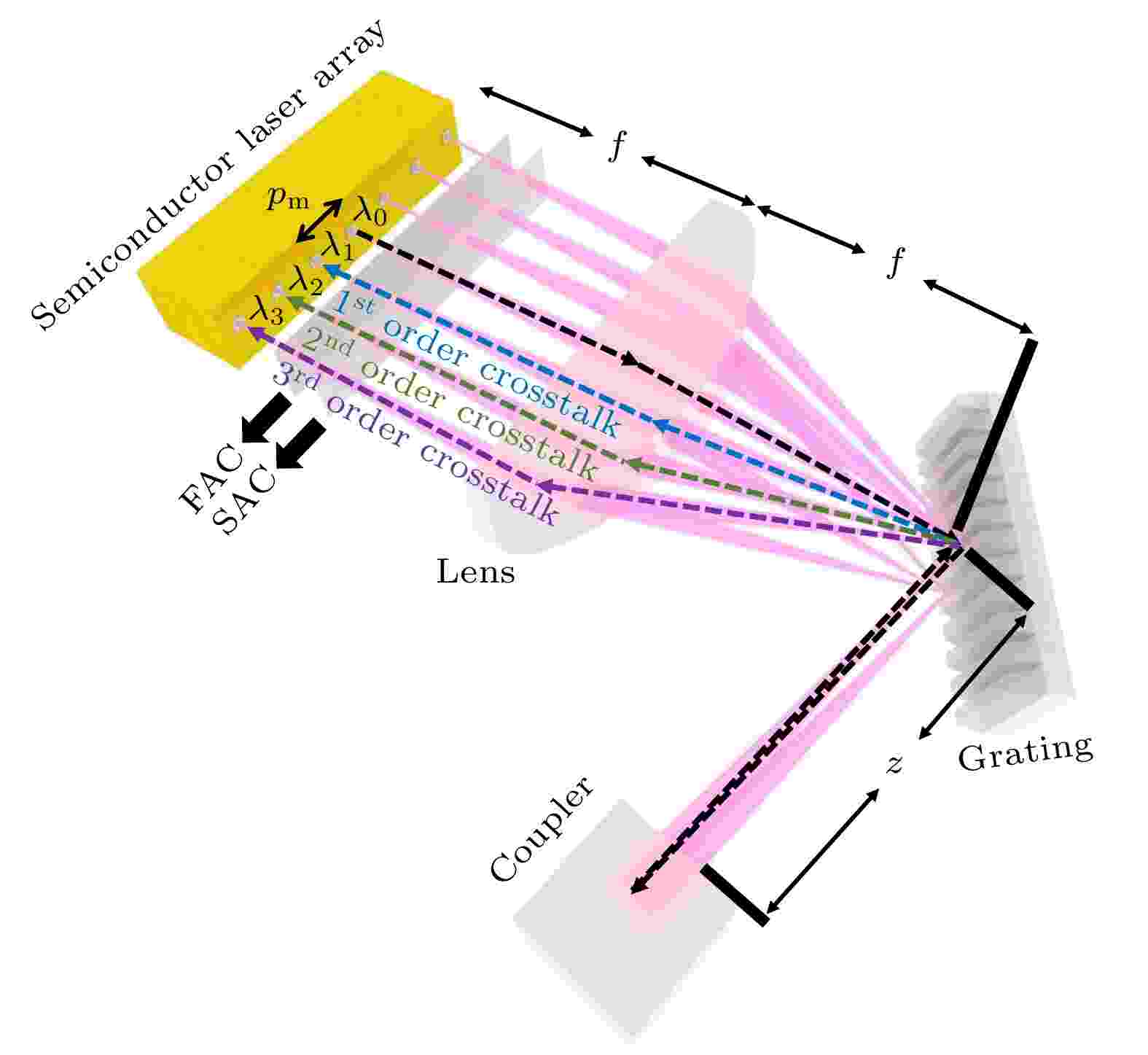
2023, 72 (2): 024206.
doi: 10.7498/aps.72.20221783
Abstract +
In spectral beam combining systems based on a grating-external cavity, due to some factors such as the “smile” effect of the semiconductor laser array and the error of the optical components in the external cavity, the beam from one emitter transmits into the external cavity and then can return to other emitters, thereby forming beam crosstalk between the two emitters. In this work, in order to investigate the physical mechanism of beam crosstalk and the influence of beam crosstalk on beam properties such as locked spectra and beam combining efficiency, based on the optical feedback semiconductor rate equation, the beam modes that can stably oscillate in the coupling cavity are derived, and the coupling cavity oscillating model is built. With the consideration of the mode competition mechanism in the coupling cavity, the effects of different crosstalk between two emitters with different intervals on the locked spectra are analyzed in detail. The results show that crosstalk leads to the shift of the peak of locked spectrum and the generation of sub-peak. The crosstalk between two closer emitters has a more serious influence on the beam spectrum structure, combined beam spot, and combining efficiency. The combining efficiencies influencing the 1st, 2nd and 3rd crosstalk are 45.5%, 50.2%, and 63.8%, respectively (When there is no crosstalk, the efficiency is 80.1%). Finally, the results of the theoretical analysis are verified experimentally, and the experimentally observed spectra under the influence of crosstalk show phenomena such as peak degradation, peak shift, edge burrs, and side lobes in spectra, which are consistent with the theoretical predictions. Moreover, according to the simulation results and experimental observations, it is found that the crosstalk can be suppressed to a certain extent by increasing the spacing between emitters, and the Galileo telescope system is suggested to suppress crosstalk and optimize the spectral structure and beam combining efficiency. Compared with the Kepler telescope structure, the Galileo telescope does not have a real focal point, which can prevent the local power from being too high, thereby damaging the optical components.

2023, 72 (2): 024207.
doi: 10.7498/aps.72.20221606
Abstract +
White upconversion (UC) luminescent materials have shown incomparable advantages over other light sources in the fields of solid-state lighting, liquid crystal display, and bioimaging, and received extensive attention from researchers. In this work, a series of microcrystals doped with different ion concentrations is synthesized by hydrothermal method, such as NaYF4: Yb3+/Ho3+/Tm3+ and NaYF4: Yb3+/Ho3+/Tm3+, and their corresponding micron core-shell (CS) structures are constructed based on epitaxial growth technology. The structure and morphology of the prepared microcrystals are characterised by X-ray diffractometer (XRD) and scanning electron microscope (SEM), showing that the microcrystal has a pure hexagonal-phase crystal structure with a rod-like shape. Under the excitation of 980 nm near-infrared laser, the white UC luminescence characteristics of Ho3+/Tm3+ and Er3+/Tm3+ co-doped single-particle NaYF4 microcrystals are systematically studied by modulating the concentration of the doping ions. The study shows that in Ho3+/Tm3+ co-doped NaYF4 microcrystals, white UC luminescence can be easily achieved by modulating the concentration of Yb3+ ions, while in the Er3+/Tm3+ co-doped NaYF4 microcrystal, the white UC luminescence can be effectively achieved by modulating the concentration of Er3+ ions. According to the luminescence characteristics of the microncrystals in different doping systems, the physical mechanism of white light emission regulation is revealed, which is mainly due to the interaction between the doped ions, including cross relaxation (CR) process and energy back transfer (EBT) process. Meanwhile, an effective enhancement of the white UC luminescence on CS microrod is achieved by coating the NaYF4 inert shell. Therefore, ion doping technique and the construction of CS structure can not only realize the white UC luminescence of microrods, but also provide important experimental reference for further enhancing the luminescence characteristics of microrods, and expand the applications of microcrystals in the fields of display, optoelectronics and anti-counterfeiting.

2023, 72 (2): 024208.
doi: 10.7498/aps.72.20221303
Abstract +

2023, 72 (2): 024209.
doi: 10.7498/aps.72.20221696
Abstract +

EDITOR'S SUGGESTION
2023, 72 (2): 024301.
doi: 10.7498/aps.72.20221793
Abstract +
Manipulation of particles by ultrasonic waves is a primary technique in the fields of precision manufacturing, materials engineering, and in vitro diagnosis, since it can control the motion of objects in the sound field in a contactless and noninvasive manner. In general, the free sound field, such as the focused field and the plane wave generated by a single transducer can only manipulate a single particle. While the complex field generated by a transducer array should be actuated by a complex electric control system, which makes the manipulation device expensive and cumbersome. Thus, modulated acoustic field for particle manipulation is still needed. Here, we experimental realize a one-dimensional acoustic grating to tune sound fields for the parallel pattern of multiple particles. The physical mechanism is that due to the resonance coupling between the periodic diffraction wave on the surface of the acoustic grating and the Fabry-Perot resonant sound field in the acoustic grating slit, a periodical gradient sound field on the surface of the acoustic grating is induced. Then, particles in the periodical gradient sound field can be trapped in two stable positions in one period of the grating. These concepts and realizations of particle patterns in the acoustic grating pave the way for implementing the parallel manipulation of particles in acoustic manipulation technologies.

2023, 72 (2): 024302.
doi: 10.7498/aps.72.20221771
Abstract +
Ballastless track is a typical bonding structure with discontinuous impedance. Under the influence of heavy load, deteriorating environment and other situations, the circumstance of debonding occurs frequently and seriously affects the safety of train operation. In this work, a high-precision array ultrasound fast imaging method is proposed. Based on the propagation path and time of sound wave in the medium obtained by ray tracing method, a theoretical model of sound velocity of discontinuous impedance bonding structure is established when the difference in sound velocity among dielectric layers is taken into account. High degree of freedom sparse array based on real number coding as well as synthetic aperture focusing technology (SAFT) imaging method is used to improve detection efficiency. The results of the experiments carried out on ballast less track structure are shown below. The ray tracing method can accurately calculate the propagation path and propagation time of ultrasonic wave and improve the detection accuracy. The optimized thinned array pattern has narrowed the main lobe width and low side lobe gain, which improves the detection efficiency and sound field directivity. The efficiency of thinned array SAFT imaging method is improved by 30.9% when the imaging error of debonding defects is within ±5%, which provides a theoretical support fordetecting such debonding defects.

2023, 72 (2): 024303.
doi: 10.7498/aps.72.20221571
Abstract +
In order to simulate the acoustic cavitation process of double-bubble coupling, based on the fluid dynamics governing equation and fluid volume fraction model, this paper proposes a three-dimensional finite element simulation model of double-bubble coupled ultrasonic cavitation in Fluent software, and numerically simulates the dynamic process of double-bubble coupled acoustic cavitation in fluid driven by ultrasonic wave. The nonlinear dynamic characteristics of coupled acoustic cavitation with double bubbles are studied by evaluating the variation of the acoustic field around the cavitation bubble. The results indicate that under the ultrasonic drive, the spherical bubbles gradually widen first to the maximal radius, then shrink swiftly, and finally collapse. There is an interaction force between the paired double bubbles, which inhibits the expansion of cavitation bubbles and increases the bubble contraction time. The ability of the cavitation bubble to converse the energy is strengthened in the contraction stage. Compared with the acoustic cavitation of the single bubble, the pressure inside the bubble is expanded when the coupled double bubble collapses. The analysis results in this paper will provide the reference for the dynamic process simulation of the ultrasonic cavitation bubbles.

EDITOR'S SUGGESTION
2023, 72 (2): 024401.
doi: 10.7498/aps.72.20221400
Abstract +
Polymers incorporated with high thermal conductivity fillers have numerous applications in thermal interface materials. Plenty of efforts have been made to improve the thermal conductivity of polymer composite. A possible method is to choose fillers with different morphologies, which can combine the advantages of various fillers. However, owing to the limitations of the effective medium theory as well as lack of researches of thermal percolation, there is still little understanding of the synergistic mechanism of fillers with different morphologies. In order to avoid the coupling effect of different materials, this work uses the same kind of Al2O3 but with different morphologies to prepare different kinds of epoxy composites incorporated with spherical Al2O3, plate-like Al2O3 and fillers mixed of 1∶1 ratio. The thermal conductivity of each sample is measured by the steady state method. With the fitting of the thermal percolation theory, the synergistic effect of plate-like fillers and that of spherical fillers are verified to promote the formation of thermal percolation network. In addition, by observing the microscopic distribution of fillers, we try to explain the mechanism of this synergistic effect.

2023, 72 (2): 024701.
doi: 10.7498/aps.72.20221472
Abstract +
The wetting and spreading of droplets on solid walls are commonly seen in nature. The study of such a phenomenon can deepen our understanding of solid-liquid interaction and promote the development of relevant cutting-edge technological applications. In this work, the lattice Boltzmann method based on phase field theory is used to investigate the wetting and spreading of a compound droplet on a wedge. This method combines the finite-difference solution of the Cahn-Hilliard equations for ternary fluids to capture the interface dynamics and the lattice Boltzmann method for the hydrodynamics of the flow. Symmetric compound droplets with equal interfacial tensions on a wedge are considered first. Through theoretical analysis and numerical simulation, it is found that the wetted area on the wedge increases with the decrease of the contact angle of the wedge surface and the wedge apex angle. Depending on these two factors, the droplet may or may not split on the wedge. We also find that the droplet near the critical state predicted not to split by static equilibrium analysis could split during the spreading along the wall of the wedge under certain density and viscosity ratios. Based on the simulation results, a phase diagram of the droplet splitting state is generated with the density ratio and viscosity ratio as the coordinates. As the density ratio and kinematic viscosity ratio increase, the inertia effect becomes more prominent in the wetting and spreading process and the droplet is more likely to split. By comparing the phase diagrams in different initial conditions, it is found that under the same conditions, the compound droplet with an equilibrium initial state is less likely to split than that with an unequilibrium initial state, which is possibly because the initial total energy of the former is relatively small. Our study also shows that the kinematic viscosity ratio between the left half and the right half droplet may affect the results of droplet splitting. The increase of such a viscosity difference is conducive to the splitting of the compound droplet. Besides, asymmetric compound droplets with unequal interfacial tensions are also simulated, and it is found that the greater the wrapping degree between the left half and right half, the more difficult it is to separate the compound droplet.

2023, 72 (2): 024702.
doi: 10.7498/aps.72.20221562
Abstract +
The thermocapillary migration of droplets on a solid surface is widely used in daily life and industrial fields. Regulating droplet thermocapillary migration by changing surface wettability has received extensive attention. According to the lubrication theory and slip boundary conditions, we establish a mathematical model of the thermocapillary migration dynamics of a droplet on wettability-confined tracks subjected to a uniform temperature gradient. Combined with the contact line dynamics, a method of determining the velocity of the contact line in a different direction of the three-dimensional droplet is proposed, the simulation is carried out with FreeFEM++. The evolution of droplet migration is examined, and the effects of track width and wettability on the droplet migration dynamics are emphatically investigated. The results show that the main part of the droplet moves from the high-temperature region to the low-temperature region, the trailing edge of the droplet forms a small bulge during the movement, and a thin liquid film is formed between the bulge and the main part of the droplet. The droplet spreading perpendicular to the track direction is inhibited and remains pinned after shrinking to the track edge. Negative correlation between the velocity of the advancing contact line and the track width is observed. The velocity of the advancing line first rapidly and then slowly decrease to a steady state. The squeezing effect caused by the wettability confined perpendicular to the track direction accelerates the thermocapillary migration of the droplet on the track in the initial short time. The enhanced track wettability increases the initial velocity of the receding contact line but has little effect on its stable value. The velocity of the advancing contact line is positively correlated with track wettability. Changing the track width is possibly easier to regulate the thermocapillary migration of a droplet than varying the track wettability.
PHYSICS OF GASES, PLASMAS, AND ELECTRIC DISCHARGES

COVER ARTICLE
2023, 72 (2): 025201.
doi: 10.7498/aps.72.20220861
Abstract +
Indirectly driven inertial confinement fusion implosions using a three-step-shaped pulse are performed at a 100 kJ laser facility. At late time of the pulse, deposition of laser energy and distribution of X-ray radiation are significantly disturbed by motion of gold plasma in the original gas-filled cylindrical hohlraum with gold wall. As a result, owing to the lack of X-ray drive at the equator of the capsule, an unacceptable oblate implosion is produced. In the I-raum modified from the above cylindrical hohlraum, the initial positions of outer laser spots and gold bubbles are appropriately shifted to modify the disturbed radiation distribution due to plasma evolution, resulting in a spherically symmetric drive on the capsule. In the implosion shots with almost the same drive pulse, owing to improved symmetry, an spherical hotspot is observed in the new I-raum, and YOS (the ratio of measured neutron yield over simulated one) is up to 30%, while an oblate hotspot is observed in the cylinder, and YOS is only 13%. The simulation calculations and experimental measurements show that the I-raum can be used to significantly reduce the impact of gold bubble expansion in the three-step-shaped pulse driven implosion, which helps to tune the drive and implosion symmetry, and to improve its over-all performance.
CONDENSED MATTER: STRUCTURAL, MECHANICAL, AND THERMAL PROPERTIES

2023, 72 (2): 026101.
doi: 10.7498/aps.72.20221553
Abstract +
Fe-based amorphous alloys are widely used in power electronics fields such as transformers and reactors due to their low coercivity, high permeability and low loss. However, the relatively low saturation magnetization (Bs) limits their further applications. Generally speaking, the adjustable magnetic Fe content as an effective strategy can ameliorate the magnetic properties, and the higher the Fe content, the higher the obtained Bs is, but the decrease of the corresponding non-magnetic element content will result in the drop of the ability of alloys to form amorphous phase, leading to the deterioration of the magnetic softness and bending ductility of nanocrystalline alloys. To address this critical issue, in this work, based on the metal-metalloid hybridization, the FePBCCu amorphous ribbons, each with a thickness of ~25 μm, are prepared by the single-roller melt spinning method via 7% (atomic percent) B substitution for P, and the effects of B element addition on the ability to form amorphous phase, magnetic properties and mechanical properties of ribbons are investigated. Thermodynamic behavior shows that the addition of small quantities of B element can reduce the structural heterogeneity of alloy and the crystallization driving force as well, thus effectively improving the thermal stability of the amorphous matrix. The melting and solidification curves show that the addition of B can promote alloy to approach to the eutectic composition, and there is a large degree of undercooling. As a result, the critical thickness of ribbons increases from ~21 μm for B-free alloy to ~30 μm for B-added alloy due to the micro-alloying effect. The addition of B increases the effective magnetic moment of magnetic atoms in alloy, resulting in the increase of the saturation magnetization. Furthermore, the results of nanoindentation tests show that the modulus value of the B-added alloy decreases greatlyr and fluctuates in a smaller range than that of the B-free alloy, which is closely associated with the structural uniformity of the alloy.
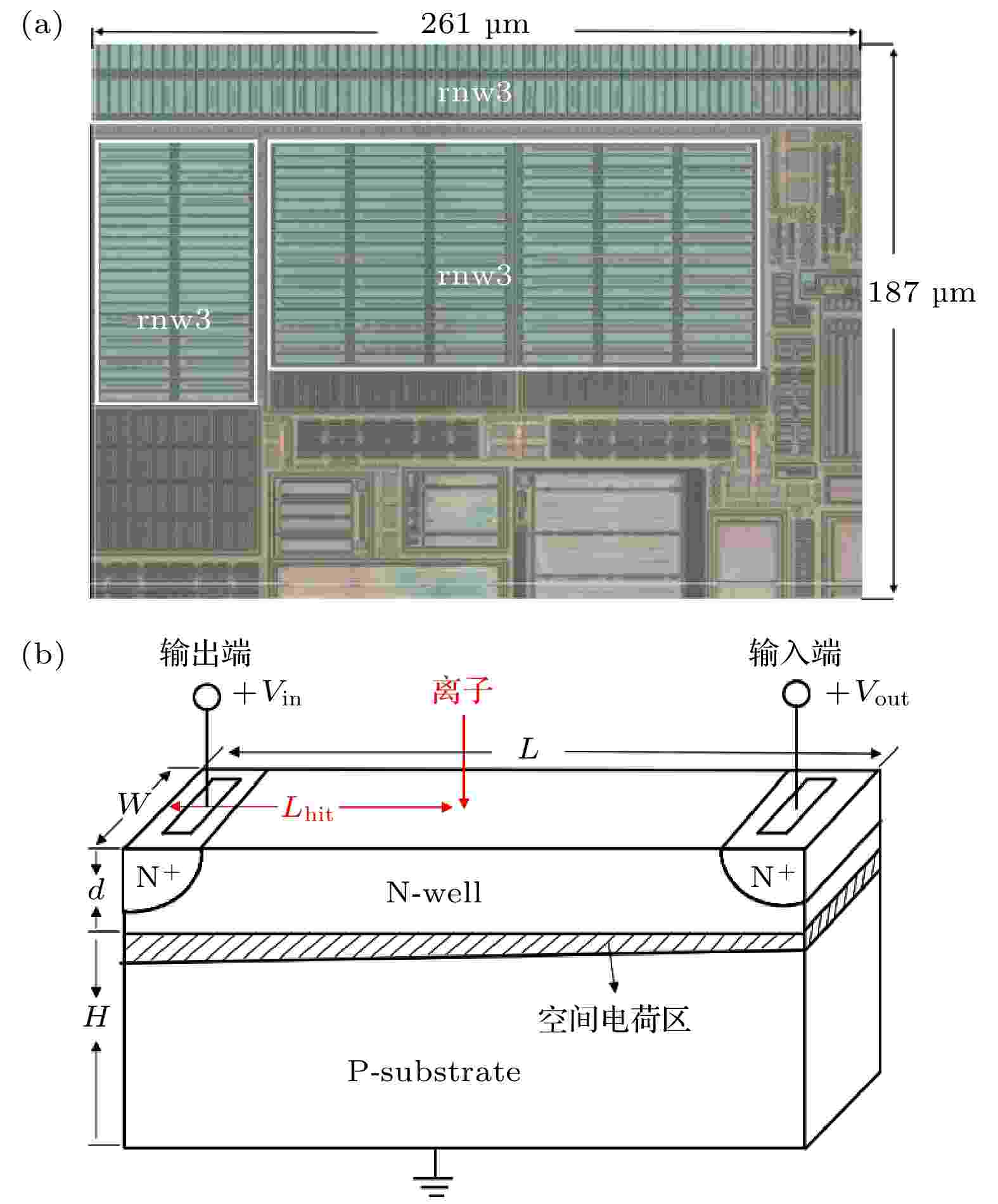
2023, 72 (2): 026102.
doi: 10.7498/aps.72.20220125
Abstract +
In this paper, the single event effect of N-well resistor is simulated by using the technology computer aided design (TCAD) software. The results indicate that a single heavy ion incident into the N-well resistor will make a disturbance in the output current of the device. The working mechanism of the N-well resistor and the physical mechanism introduced by the single event effect are studied. The results show that ion-induced electron-hole pairs neutralize the depletion region in the N-well substance that provides high impedance for the device, resulting in the instantaneous increase of the output current. The larger the destroyed area of the depletion region in the N-well resistor, the higher the peak value of the transient output current is. But the ion-induced disturbance can disappear with the collection of the high concentration of excess carriers in the N-well structure. However, the unique aspect ratio design of the N-well resistor makes only the carriers close to the input drift to output under the electric field. And, the drift motion of carriers takes a lot of time because of the long transport distance, which leads to low efficiency of collecting excess carriers and a long duration of ion-induced disturbance in the N-well resistor. Besides, some other factors that can affect the single event effect in the N-well resistors are also studied in this paper. The results show that the higher the LET value of ions and the farther the incident location from the input, the more serious the single event effect of N-well resistance is. In addition, properly shortening the length of the N-well resistor and increasing the input voltage of the N-well resistor can enhance its resistance to single event effect.

2023, 72 (2): 026801.
doi: 10.7498/aps.72.20221676
Abstract +
Friction generally occurs in the relative motion or the contact interface with the trend of relative motion, which impedes the relative motion and produces energy loss. Micro-scale friction is different from the macro-scale friction due to surface effects and other factors. It is necessary to study the friction behavior on a nano-scale. First-principles method is an important way to study and understand friction on a nano-scale. Nevertheless, the constructing of nearly a thousand models and the processing of a large number of data are very time consuming. In this paper, we establish a high-throughput computational program based on the first-principles method to study the interfacial friction of two-dimensional materials. The program realizes modeling, submitting computation tasks, multi-task concurrent calculation, data collection and processing, and image rendering of calculation results. All of these are done in batch automatically, which greatly saves researchers’ time. In this work, this program is used to simulate the normal load by changing the distance between layers and calculate the potential energy surface of BN/BN and graphene/graphene bilayer sliding systems at a series of interlayer distances, as well as the interlayer friction forces and friction coefficients. The study finds that with the decrease of the interlayer distance, the averaged friction force at BN/BN interface increases approximately linearly, and the friction coefficient is in a range of 0.11–0.17. The friction force at graphene/graphene interface first increases, then decreases, and increases again. The friction coefficient reaches a minimum value (0.014) under a load of 12 nN, and these results are consistent with the previous results, verifying the reliability of the calculation program. In addition, we investigate the effect of surface hydrogenation and fluorination on the tribological property of the BN bilayer and find that the friction at the fluorinated BN/BN interface decreases, which is attributed to the smaller charge transfer at interface. Although the high-throughput calculation method realizes the automation and high-throughput calculation of tribological property at solid interface, there are still some limitations. Firstly, the effect of interlaminar bending is not considered in the process of interlaminar relative sliding. Secondly, the essence of the calculation result is static friction, rather than dynamic friction. In addition, the method does not consider the influence of temperature.
CONDENSED MATTER: ELECTRONIC STRUCTURE, ELECTRICAL, MAGNETIC, AND OPTICAL PROPERTIES

2023, 72 (2): 027101.
doi: 10.7498/aps.72.20221842
Abstract +
Using solar photoelectrochemical decomposition of water to produce hydrogen and oxygen is one of the most feasible approaches to obtaining renewable energy. Compared with hydrogen-evolution reaction (HER), the oxygen-evolution reaction (OER) is very complex, there are four sluggish proton-coupled electron transfer processes. It is critical to improve OER performance. The BiVO4 (010) facet possesses low surface energy, strong visible absorption, and good activity for OER, and is considered as one of the most suitable PEC catalysts. However, its poor electron conductivity, low charge carrier mobility, and high charge recombination rates significantly limit its practical applications. To achieve highly active OER photocatalysts, we modify BiVO4 (010) facet by substitutial doping with Al atom and surface adsorption with Al atom. According to density functional theory calculations, we compare OER performances of these two modified BiVO4 (010) facets. The results show that both approaches can effectively regulate the electronic structure of BiVO4 and then tune OER activity resulting from the change of the structure. Though Al substitutional doping reduces the band gap of the (010) facet and enhances the visible light absorption, the improvement of OER performance is not significant because the doping site is inside and has little influence on the surface active site. Importantly, the surface adsorption of Al atom is considered as an efficient means to improve the OER activity on BiVO4 (010) facet due to the combined action between surface adsorbed Al and active site Bi atoms. Al adsorbed (010) facet exhibits excellent OER catalytic activity: 1) the induction of localized states and the reduction of band gap are conducive to the electronic transition, optical absorption, thus increasing the electrical conductivity; 2) there is lower hole effective mass, and thus effectively enhancing the ability to transfer from anode surface to electrolyte surface, thereby increasing the difference between the effective mass ratio of electron−hole pairs and 1 and effectively reducing the electron-hole recombination; 3) the nteraction between the active sites and oxygen-containing intermediates is reinforced in the OER process, therefore the potential determining step of OER decreases effectively. This work provides an important reference for designing efficient and stable two-dimensional semiconductor-based photocatalysts for OER. We believe that it will arouse great interest of the BiVO4 community and motivate numerous experimental researches.

2023, 72 (2): 027301.
doi: 10.7498/aps.72.20221738
Abstract +
The deep-ultraviolet (DUV) photodetectors (PDs) have important applications in lots of fields. Thus, developing self-powered DUV PDs and excavating the inherent mechanism seem seriously crucial to achieving further actual applications. The construction of heterojunction can lead to many desired characteristics in optoelectronic devices. In the field of DUV photodetection, Ga2O3 has been a popular subject for constructing DUV PDs. So, it is necessary to develop self-powered Ga2O3-based DUV PDs through fabricating its heterogeneous structure. Therefore, in this work, the Ga2O3/Al0.1Ga0.9N heterojunction DUV PD is fabricated and discussed, which can achieve 254 and 365 nm DUV light photodetection. At positive voltages and negative voltages, the heterojunction PD can operate in a photoconductive mode or a depletion mode, respectively. In view of the PD performance, it displays decent dark current and DUV photoresponses. At voltage of 5 and –5 V, under 254 nm DUV light illumination, the photoresponsivity (R) is 2.09 and 66.32 mA/W, respectively, while under 365 nm DUV light illumination, R is 0.22 and 34.75 mA/W, respectively. In addition, under the built-in electric field (Ebuilt-in), R is 0.13 and 0.01 mA/W for 254 nm and 365 nm DUV light illumination, respectively. In all, the fabricated heterojunction PD displays promising prospects in the coming next-generation semiconductor photodetection technology. The results in this work indicate the potential of Ga2O3/Al0.1Ga0.9N heterojunction with high performance DUV photodetection. Furthermore, except for the characterizations of the materials and photodetector, in the end of this paper, the operating mechanism of the dual-band dual-mode heterojunction PD is analyzed through its heterogeneous energy-band diagram. It is concluded that the illustrated dual-band dual-mode Ga2O3/Al0.1Ga0.9N heterojunction can be sensitive to UVA waveband and UVC waveband in the electromagnetic spectrum, extending its photodetection region. And, the dual-mode (photoconductive mode and depletion mode) photodetection indicates two kinds of carrier transports in one PD, which can be attributed to the successful construction of the N-N tomo-type Ga2O3/Al0.1Ga0.9N heterojunction.
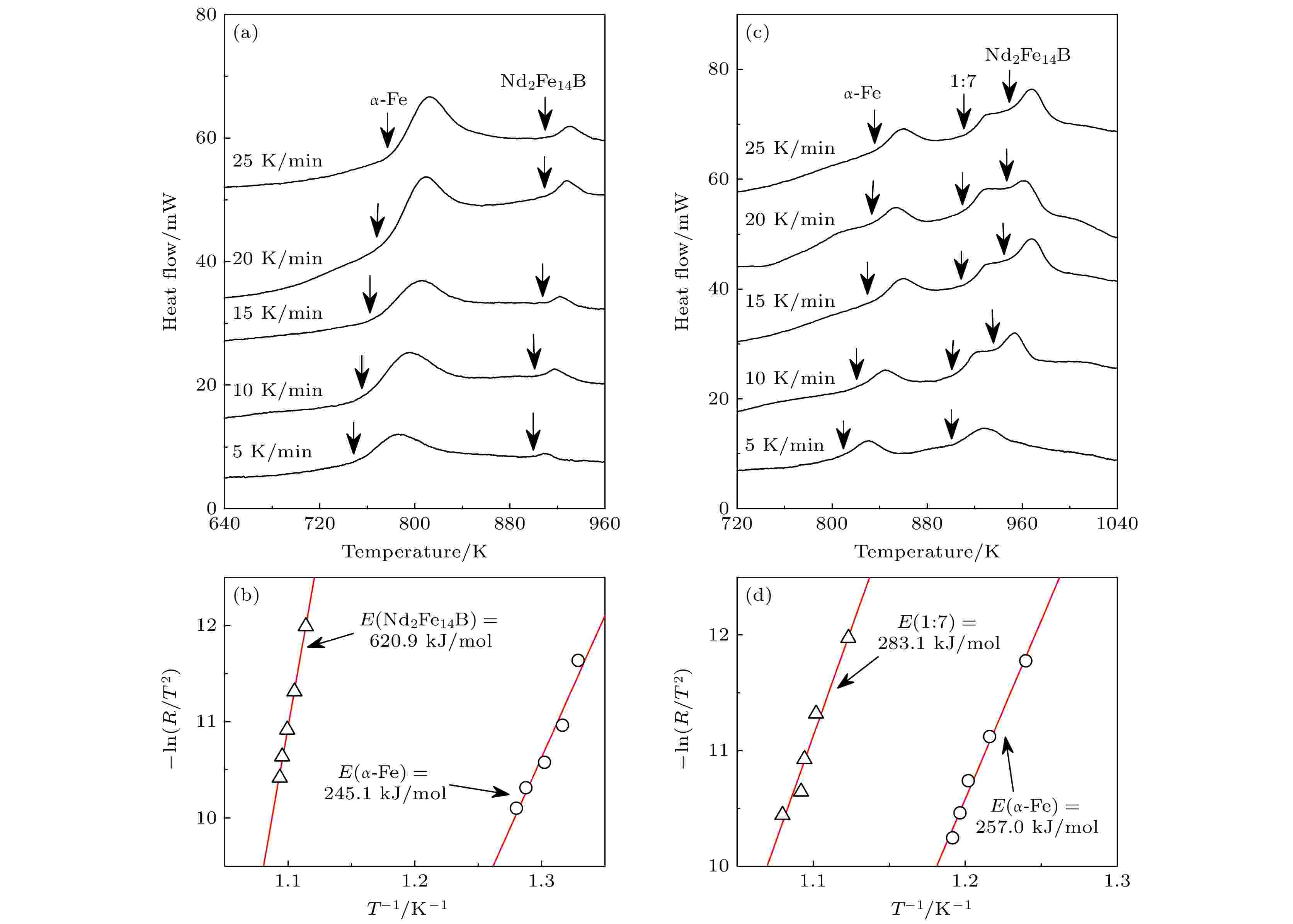
2023, 72 (2): 027501.
doi: 10.7498/aps.72.20221479
Abstract +
Nanocomposite magnet consisting of a fine mixture of magnetically hard and soft phase has received much attention for potential permanent magnet development. One of the important requirements for alloys to exhibit excellent magnetic properties is a nanocrystalline grain size. The soft and hard magnetic phases can simultaneously achieve ideal nanoscale composites. The effect of Ti additions in the amorphous crystallization process of the exchange-coupled nanocomposite Nd2Fe14B/α-Fe magnet prepared by melt spinning is investigated. The results show that Ti can change the crystallization kinetics of the NdFeB melt-spun ribbons. The Ti can increase the activation energy of α-Fe and contrarily reduce the activation energy of a metastable 1∶7 phase, so the growth speed of α-Fe decreases and the metastable 1∶7 phase can stably precipitate from the amorphous phase. When the annealing temperature increases, a metastable 1∶7 phase is decomposed into the α-Fe phase and the Nd2Fe14B phase. The microstructure observation shows that the grains of the alloys doped with Ti are fine and uniform, with an average grain size of about 20 nm, and no particularly large α-Fe particles appear. The optimal magnetic property is (BH)max = 12 MG·Oe (1 G = 10–4 T, 1 Oe = 79.57795 A/m) when Ti addition is 1.0%.
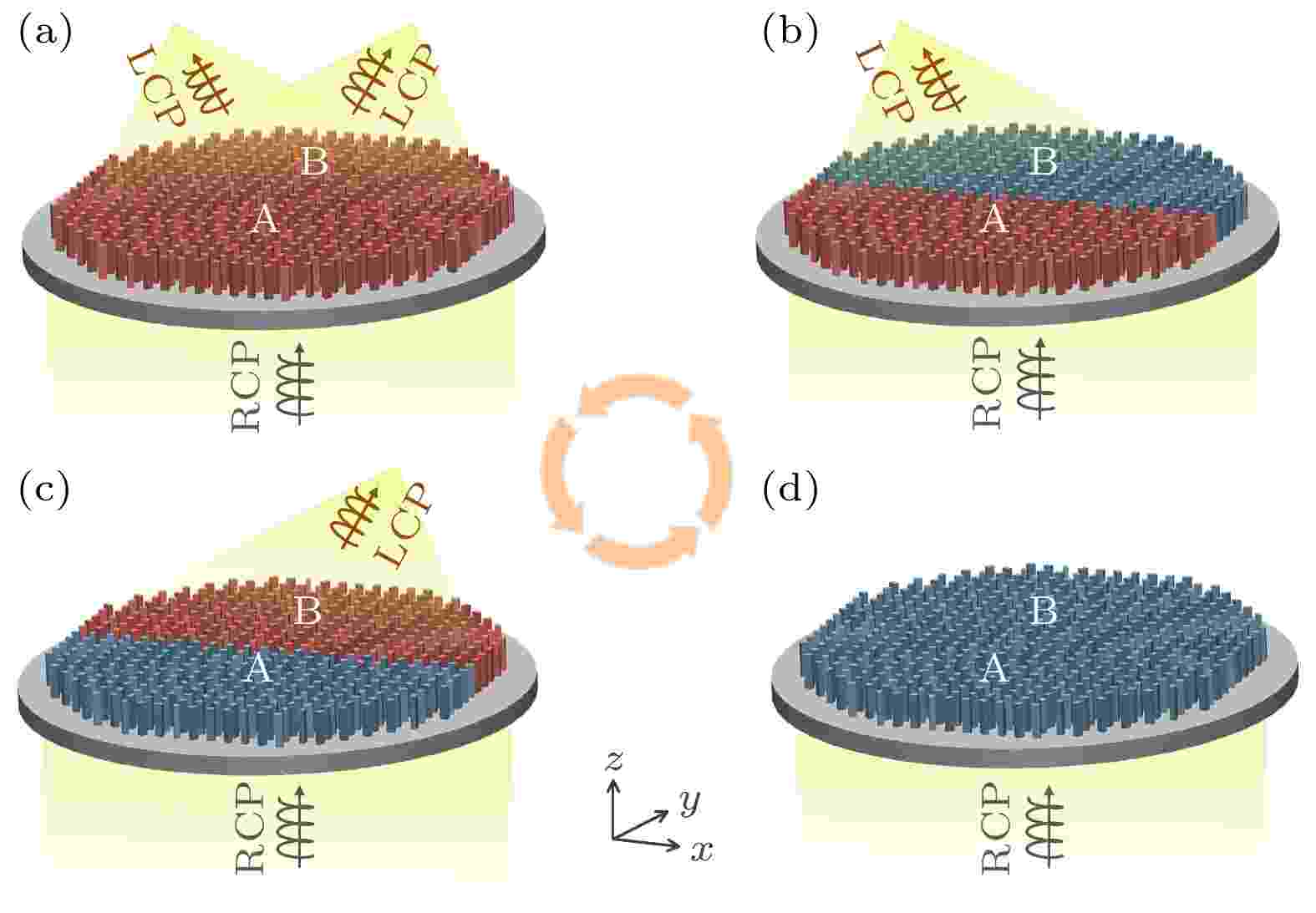
2023, 72 (2): 027801.
doi: 10.7498/aps.72.20221794
Abstract +
Novel dual-trap and multi-trap optical tweezers are designed and analyzed, in order to enhance the particle trapping performance of optical tweezers in three-dimensional (3D) space. Firstly, controllable dual-trap optical tweezers are proposed based on metalens and the low-loss optical phase-change material Sb2S3. The horizontal and axial analysis of the optical force acting on two 250-nm-radius SiO2 particles are also carried out. The simulation results show that when Sb2S3 is in the crystalline state, the transverse optical trap stiffness $ {k}_{x} $ of two particles reaches about 25.7 pN/(μm·W) and 37.4 pN/(μm·W), respectively, and the axial optical trap stiffness $ {k}_{z} $ for each particle is about 10.0 pN/(μm·W). When the Sb2S3 is in the amorphous state, both $ {k}_{x} $ and $ {k}_{z} $ are about 1/10 of the counterpart of its crystalline state. As a result, the particle is not stably trapped in the z-direction, and thus enabling the controllability of trapping particles in 3D space. Furthermore, array-type multi-trap optical tweezers are proposed. By regulating the crystal state and noncrystal state of phase-change material Sb2S3, it is convenient to form different combinations of 3D trap schemes. These new optical tweezers can realize 3D space particle trap in various ways, thereby improving the flexibility of optical tweezers, and providing a series of new ways of implementing the metalens-based optical tweezers.
INTERDISCIPLINARY PHYSICS AND RELATED AREAS OF SCIENCE AND TECHNOLOGY

EDITOR'S SUGGESTION
2023, 72 (2): 028101.
doi: 10.7498/aps.72.20221736
Abstract +
On the basis of a large number of experimental data, it is a challenge to establish a data-driven non-linear law between mixing characteristics and mechanical properties for the proportioning and process design of new alloy compositions. This paper proposes a performance-oriented “composition-process-property” design strategy for Al-Si-Mg alloys based on a machine learning approach, aiming to adopt multimodal experimental data on the composition, melting and heat treatment processes of divergent grades of the same system as features, and a random forest algorithm is used to find the non-linear pattern between the features and the tensile strength. Afterward, this paper sets the composition and process parameters of some of the alloys in the dataset as the target null values and uses the chain equation multiple interpolation algorithms to predict the interpolation of the target missing data. The errors of both experimental and predicted values of tensile strength of the alloys predicted or guided by this strategy are kept within ±5%; The composition ratio of Al-6.8Si-0.6Mg-0.05Sr and the heat treatment scheme of 540 ℃×10 h+170 ℃×10 h are experimentally confirmed to have a quality index QDJR of 517.3 for comprehensive tensile properties, which is higher than that of similar alloys below a QDJR value of 500. The result indicates that this strategy helps to enhance the long cycle time, high cost, and low efficiency of the traditional design method for Al-Si-Mg system alloys.
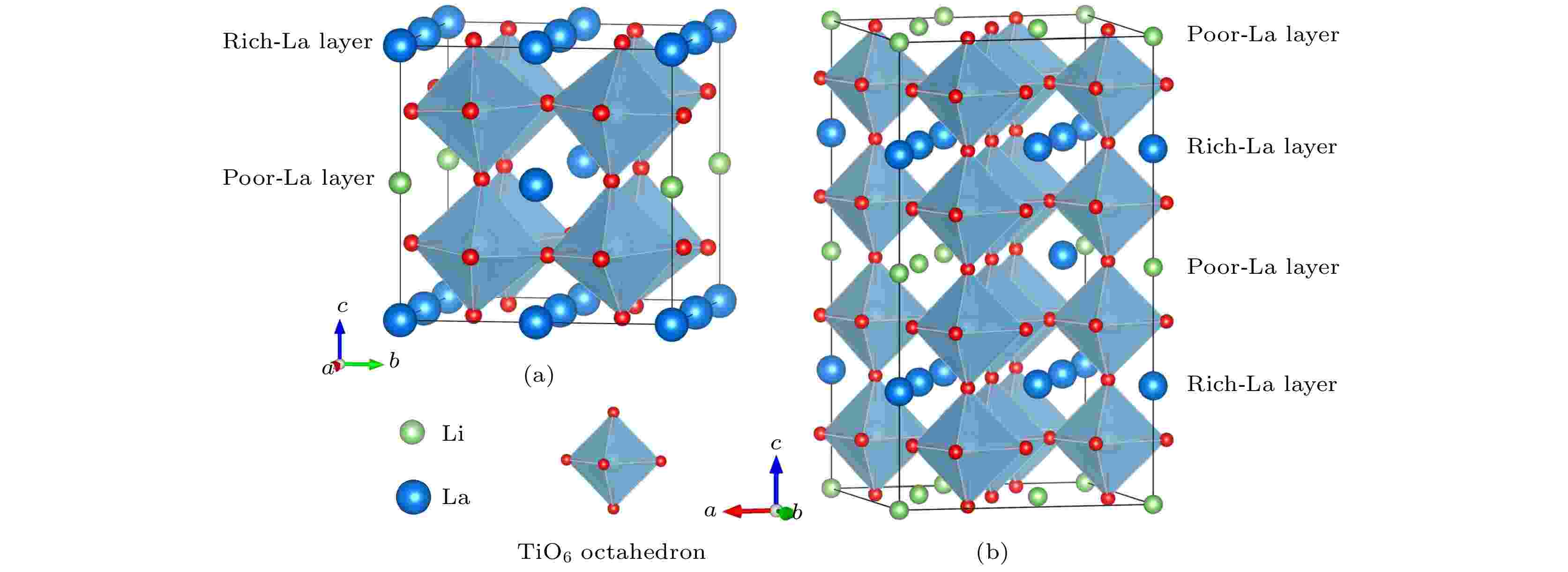
2023, 72 (2): 028201.
doi: 10.7498/aps.72.20221808
Abstract +
Li3xLa(2/3)–x†(1/3)–2xTiO3(LLTO) is a promising solid-state electrolyte for Li-ion batteries. We study the effect of Li content on the stability, electronic and Li-ion diffusion properties of LLTO surface based on first-principles and molecular dynamics simulations. We consider both Li-poor and Li-rich LLTO surfaces. The results show that La/O/Li-terminated LLTO (001) is the most stable crystal surface. Further, LLTO (001) surface gives better stability when Li content is 0.17, 0.29, and 0.38 for Li-poor phase, while 0.33, 0.40, and 0.45 for Li-rich phase . Electronic structure calculations infer that in both Li-poor and Li-rich LLTO(001) surfaces there occurs the transition from conductor to semiconductor with the increase of Li content. Besides, we find that Li-ion always keeps a two-dimensional diffusion path for different Li content. As Li content increases from 0.17 to 0.38 for Li-poor LLTO (001) surface, Li-ion diffusion coefficient increases gradually and Li-ion diffusion barrier decreases from 0.58 eV to 0.42 eV. Differently, when Li content increases from 0.33 to 0.45 for Li-rich LLTO(001) surface, it does not follow a monotonic trend for diffusion coefficient nor for diffusion barrier of Li-ion. In this case, Li-ion diffusion coefficient is the largest and Li-ion diffusion barrier is the lowest (0.30 eV) when Li content is 0.40. Thus, our study suggests that by varying Li content, the stability, band gap, and Li-ion diffusion performance of LLTO (001) can be changed favorably. These advantages can inhibit the formation of lithium dendrites on the LLTO (001) surface.

2023, 72 (2): 028301.
doi: 10.7498/aps.72.20221633
Abstract +
The propagation speed is one of the important parameters of the internal solitary wave (ISW). How to obtain the ISW speed through optical remote sensing images accurately and quickly is an important problem to be solved. In this paper, we simulate ISW optical remote sensing imaging, obtain an experimental database, and build the ISW speed inversion model based on a single-scene optical remote sensing image by using the least squares method and the support vector machine. The accuracy of the ISW speed inversion model is tested by using MODIS Image and GF-4 image data of the South China Sea. The study results are shown below. The least squares ISW speed inversion model can give the regression equation, which is more intuitive and has less accuracy in the water depth ranging from 300 m to 399 m, while the support vector machine ISW speed inversion model has high accuracy in the water depth ranging from 400 m to 1200 m and from 83 m to 299 m. Therefore, the two kinds of ISW speed inversion models have different advantages, and can be applied to the inversion of the ISW speed in the real ocean.

2023, 72 (2): 028501.
doi: 10.7498/aps.72.20221545
Abstract +
The β-Ga2O3 has received much attention in the field of power and radio frequency electronics, due to an ultrawide bandgap energy of ~4.9 eV and a high breakdown field strength of ~8 MV/cm (Poncé et al. 2020 Phys. Rev. Res. 2 033102 ). The in-plane lattice mismatch of 2.4% between the ($ \bar 201 $ ) plane of β-Ga2O3 and the (0002) plane of wurtzite AlN is beneficial to the formation of an AlN/β-Ga2O3 heterostructure (Sun et al. 2017 Appl. Phys. Lett. 111 162105 ), which is a potential candidate for β-Ga2O3-based high electron mobility transistors (HEMTs). In this study, the Schrödinger-Poisson equations are solved to calculate the AlN/β-Ga2O3 conduction band profile and the two-dimensional electron gas(2DEG) sheet density, based on the supposition that the 2DEG originates from door-like surface states distributed evenly below the AlN conduction band. The main scattering mechanisms in AlN/β-Ga2O3 heterostructures, i.e. the ionized impurity scattering, interface roughness scattering, acoustic deformation-potential scattering, and polar optical phonon scattering, are investigated by using the Boltzmann transport theory. Besides, the relative importance of different scattering mechanisms is evaluated. The results show that at room temperature, the 2DEG sheet density increases with the augment of AlN thickness, and reaches 1.0×1013 cm–2 at an AlN thickness of 6 nm. With the increase of the 2DEG sheet density, the ionized impurity scattering limited mobility increases, but other scattering mechanisms limited mobilities decrease. The interface roughness scattering dominates the mobility at low temperature and moderate temperature (T < 148 K), and the polar optical phonon scattering dominates the mobility at temperatures above 148 K. The room-temperature mobility is 368.6 cm2/(V·s) for the AlN/β-Ga2O3 heterostructure with an AlN thickness of 6 nm.
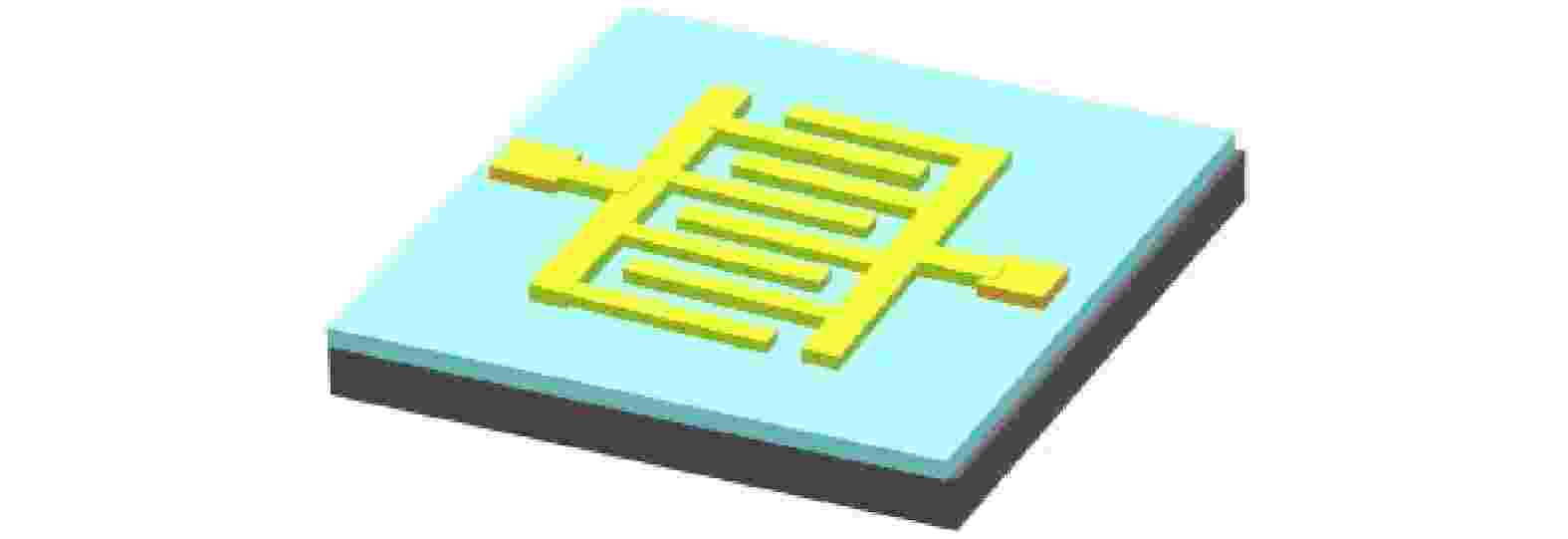
Effects of annealing temperature on properties of gallium oxide thin films and ultraviolet detectors
2023, 72 (2): 028502.
doi: 10.7498/aps.72.20221716
Abstract +
In this work, gallium oxide (Ga2O3) thin films are deposited on quartz substrates by radio frequency magnetron sputtering at room temperature and annealed in argon atmosphere at different temperatures. The influences of annealing temperatures in the argon atmosphere on crystal structure, transmittance, surface morphology, and optical band gap of the samples are investigated in detail. It is found that the annealing process can improve the crystalline quality of the film, but high-temperature annealing can also easily cause oxygen elements in the film to escape from the film to form oxygen vacancies, which is evidenced by XPS test results. To obtain the effect of the annealing process on the performance of gallium oxide thin film detector, the metal-semiconductor-metal (MSM) photodetector based on the sample annealed at 800 °C, which is compared with untreated sample operated at a reverse bias voltage of 1.1 V, can achieve excellent comprehensive photo-detection properties for 254 nm ultraviolet light: the light-dark current ratio (I254/Idark), responsivity and specific detectivity are as high as 1021.3, 0.106 A/W and 1.61 × 1012 Jones, respectively, which are 7.5, 195 and 38.3 times those of the unannealed sample device. And the external quantum efficiency is improved by 51.6%. The rise time of sample detector (0.19/0.48 s) annealed at 800 ℃ decreases compared with that of the unannealed sample (0.93/0.93 s), and the descent time of 800 ℃ detector (0.64/0.72 s)increases compared with that of the unannealed sample (0.45/0.49 s), respectively. By comparing the parameters with those of other current gallium oxide-based MSM photodetectors, it is found that the detector parameters of this work have some gaps compared with the current optimal parameters, which is attributed to the fact that the quartz substrate is selected for this work and not the sapphire substrate that is better matching with gallium oxide, resulting in the poor quality of the film compared with that of the sample on the sapphire substrate, and in this work, the photodetector has the high light-dark current ratio (PDCR) and detection rate (D*). In the end, the mechanism of increasing oxygen vacancies after being annealed, which leads to the improvement of detector performance parameters, is analyzed in detail.

2023, 72 (2): 028503.
doi: 10.7498/aps.72.20221381
Abstract +
Nanothick semiconductors can grow orderly along a desired direction with the help of modern materials growth technology such as molecular beam epitaxy, which allows researchers to fabricate the so-called layered semiconductor nanostructure (LSN) experimentally. Owing to the structure inversion symmetry broken by the layered form in the LSN, the electron spins interact tightly with its momentums, in the literature referred to as the spin-orbit coupling (SOC) effect, which can be modulated well by the interfacial confining electric field or the stain engineering. These significant SOC effects can effectively eliminate the spin degeneracy of the electrons in semiconductor materials, induce the spin splitting phenomenon at the zero magnetic field and generate the electron-spin polarization in the semiconductors. In recent years, the spin-polarized transport for electrons in the LSN has attracted a lot of research interests, which is because of itself scientific importance and potential serving as spin polarized sources in the research field of semiconductor spintronics. Adopting the theoretical analysis combined with the numerical calculation, we investigate the spin-polarized transport induced by the Rashba-type SOC effect for electrons in a single-layered semiconductor nanostructure (SLSN)-InSb. The present research is to explore the new way of generating and manipulating spin current in semiconductor materials without any magnetic field, and focuses on developing new electron-spin filter for semiconductor spintronics device applications. The improved transfer matrix method (ITMM) is exploited to exactly solve Schrödinger equation for an electron in the SLSN-InSb device, which allows us to calculate the spin-dependent transmission coefficient and the spin polarization ratio. Owing to a strong Rashba-type SOC, a considerable electron-spin polarization effect appears in the SLSN-InSb device. Because of the effective potential experienced by the electrons in the SLSN-InSb device, the spin polarization ratio is associated with the electron energy and the in-plane wave vector. In particular, the spin polarization ratio can be manipulated effectively by an externally-applied electric field or the semiconductor-layer thickness, owing to the dependence of the effective potential felt by the electrons in the SLSN-InSb device on the electric field or the layer thickness. Therefore, such an SLSN-InSb device can be used as a controllable electron-spin filter acting as a manipulable spin-polarized source for the research area of semiconductor spintronics.
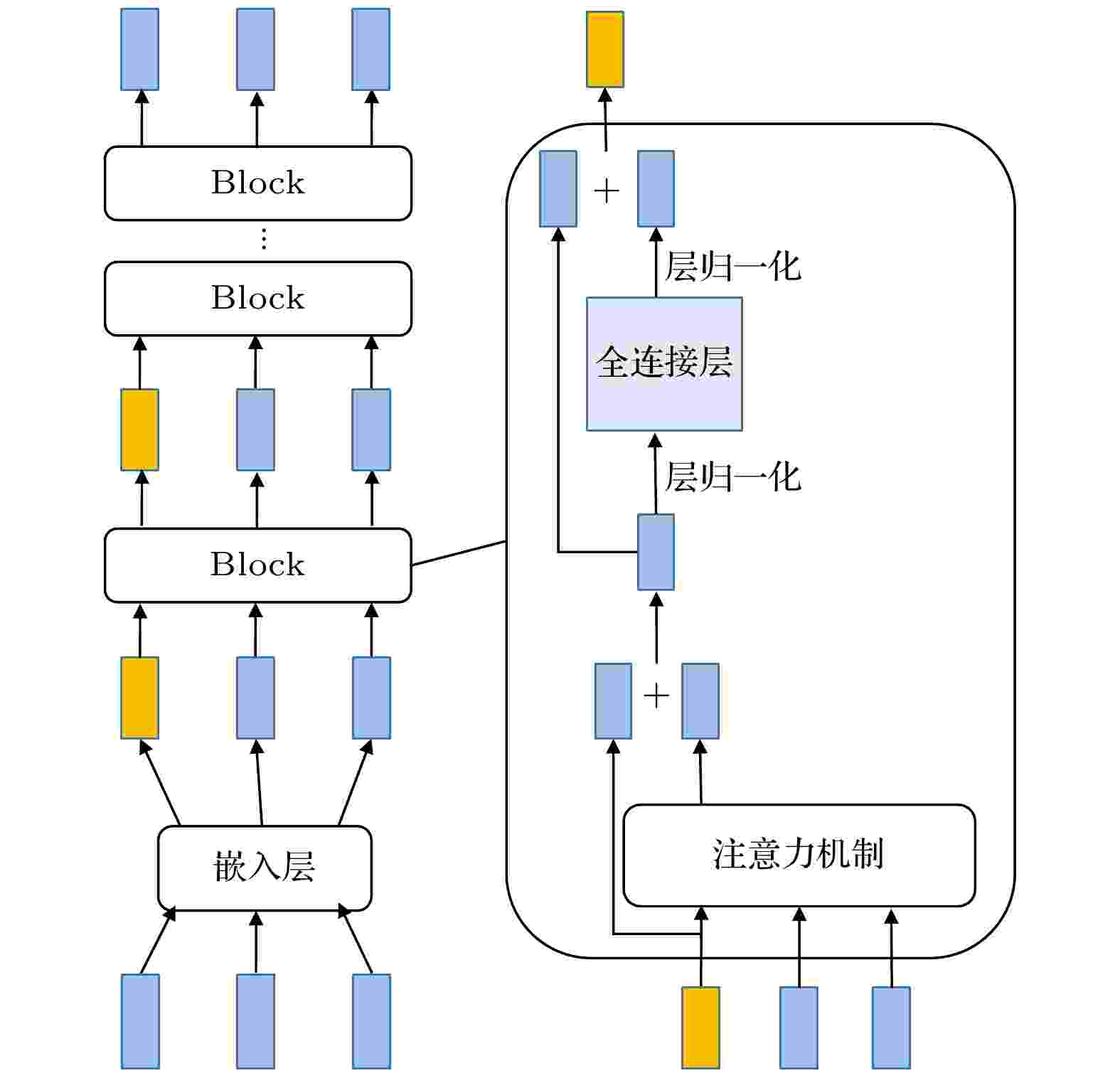
2023, 72 (2): 028901.
doi: 10.7498/aps.72.20221374
Abstract +
With the development of artificial intelligence, machine learning (ML) is more and more widely used in material computing. To apply ML to the prediction of material properties, the first thing to do is to obtain effective material feature representation. In this paper, an atomic feature representation method is used to study a low-dimensional, densely distributed atomic eigenvector, which is applied to the band gap prediction in material design. According to the types and numbers of atoms in the chemical formula of material, the Transformer Encoder is used as a model structure, and a large number of material chemical formula data are trained to extract the features of the training elements. Through the clustering analysis of the atomic feature vectors of the main group elements, it is found that the element features can be used to distinguish the element categories. The Principal Component Analysis of the atomic eigenvector of the main group element shows that the projection of the atomic eigenvector on the first principal component reflects the outermost electron number corresponding to the element. It illustrates the effectiveness of atomic eigenvector extracted by using the transformer model. Subsequently, the atomic feature representation method is used to represent the material characteristics. Three ML methods named Random Forest (RF), Kernel Ridge Regression (KRR) and Support Vector Regression (SVR) are used to predict the band gap of the two-dimensional transition metal chalcogenide compound MXY (M represents transition metal, X and Y refer to the different chalcogenide elements) with Janus structure. The hyperparameters of ML model are determined by searching for parameters. To obtain stable results, the ML model is tested by 5-fold cross-validation. The results obtained from the three ML models show that the average absolute error of the prediction using atomic feature vectors based on deep learning is smaller than that obtained from the traditional Magpie method and the Atom2Vec method. For the atomic eigenvector method proposed in this paper, the prediction accuracy of the KRR model is better than that of the results obtained from the Magpie method and Atom2Vec method. It shows that the atomic feature vector proposed in this paper has a certain correlation between the features, and is a low-dimensional and densely distributed feature vector. Visual analysis and numerical experiments of material property prediction show that the atomic feature representation method based on deep learning extraction proposed in this paper can effectively characterize the material features and can be applied to the tasks of material band gap prediction.
GEOPHYSICS, ASTRONOMY, AND ASTROPHYSICS

2023, 72 (2): 029501.
doi: 10.7498/aps.72.20221645
Abstract +
Cosmic-ray muon is a kind of charged particle with strong penetrating capability and sensitivity to high atomic number materials. In recent years, muongraphy emerged as a novel technique by using cosmic-ray muon to image unknown volume, and is widely applied to nuclear security, geosciences, archaeology and civil engineering. The effect of multiple Coulomb scattering between muons and materials with different atomic number is different, and the scattering angle is related to material Z and muon energy. If we can measure muon scattering angle and muon energy, we can identify the category of material interacted with muon. However, it is difficult to measure the energy of each muon in real time, most of the researches use the mean muon energy ~4 GeV to alternate each muon energy which causes image to blurred and material discrimination accuracy to decrease. This article introduces a method of using the discrete muon energy to fit the scattering angle distribution derived from continuous muon energy and estimate the weight of each discrete muon energy. Then measure the scattering angle of the material to be identified, histogram the scattering angle and couple it with the calibrated scattering angle distribution by discrete muon energy. The last step is to calculate the radiation length from the above equation. The radiation length is a characteristic quantity of the material, and used to identify materials in this method. We carry out the experiment on material’s discrimination based on the apparatus of cosmic-ray muon tomography made by China Institute of Atomic Energy. The system contains 6 layers, consisting of several drift tube detectors planted in two orthogonal coordinate for tracking muon trajectory. Five materials are selected to be distinguished in the experiment, they being C, Al, Fe, Pb, and W. The scattering angles formed by muons passing through these materials are measured respectively, and their radiation lengths are measured and identified in pairs. In order to evaluate material discrimination accuracy, we plot the ROC curve between each pair of materials. The result reveals that Al-Fe and Fe-Pb can be effectively identified at a 95% confidence level, under 1400 valid muon events. Considering that the difference in material density also influences discrimination accuracy, we simulate several other materials identified by Pb. It is concluded that this method can identify the materials with radiation length greater than 0.7 cm. Compared with the discrimination method of unknowing muon energy, this method improves the accuracy of Pb-W discrimination by 18.5%.
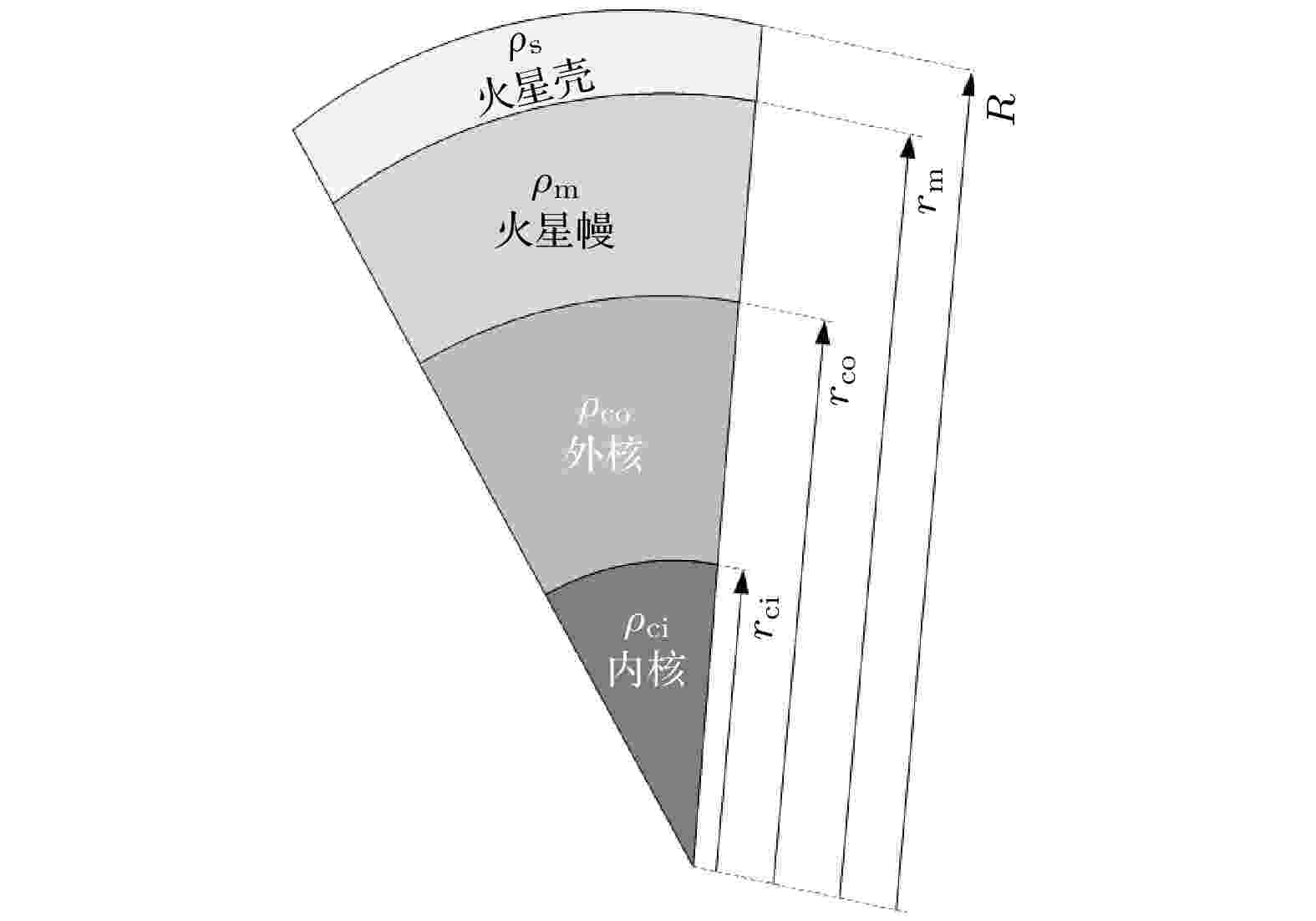
EDITOR'S SUGGESTION
2023, 72 (2): 029601.
doi: 10.7498/aps.72.20221170
Abstract +
It is still difficult to detect the existence of Martian solid inner core merely based on Mars seismic InSight data. To deal with this problem, our study intends to use the mean density and mean moment of inertia factor to constrain the size and density of Martian solid inner core. Using the Mars high-degree gravity field models: JGMRO120f and GMM3-120, and considering the recent precession rate, we obtain the mean density and mean moment of inertia factor, which are treated as the observed values. Referring to the 4-layers internal structure model of Mars, and considering the 4 parameters, i.e. crustal density, mantle density, density of outer core, size and density of inner core, we calculate the modeled values of the Martian mean density and the mean moment of inertia factor. From the minimum residuals between observed and modeled values of mean density as well as that of mean moment of inertia factor, it is found that the two gravity field models have the same result of distribution of free parameters. As to the optimized values of the free parameters, the two gravity field models even have the same results. Furthermore, the optimized crustal density, mantel density and density of outer core approach other studies, indicating the dependence of our results. Finally, our result demonstrates that Mars likely has a solid inner core with a size close to 840 km, and the density of inner core is nearly 6950 kg⋅m–3. Our result implies that Mars has an inner core not fully composed of pure iron, which is consistent with the recent study that Mars requires a substantial complement of light elements in Martian core. However, it is further needed to constrain the size and composition of Martian inner core due to the non-uniqueness of inversion results. With the improvement of processing technology on the InSight data, it can be further constrained for the size and composition of Martian inner core.


































